Nutrition
The Surprising Link Between Personality and Food Preferences
Beneath your food choices lies a fascinating connection to your personality—what secrets could your cravings reveal about you? Discover more inside!
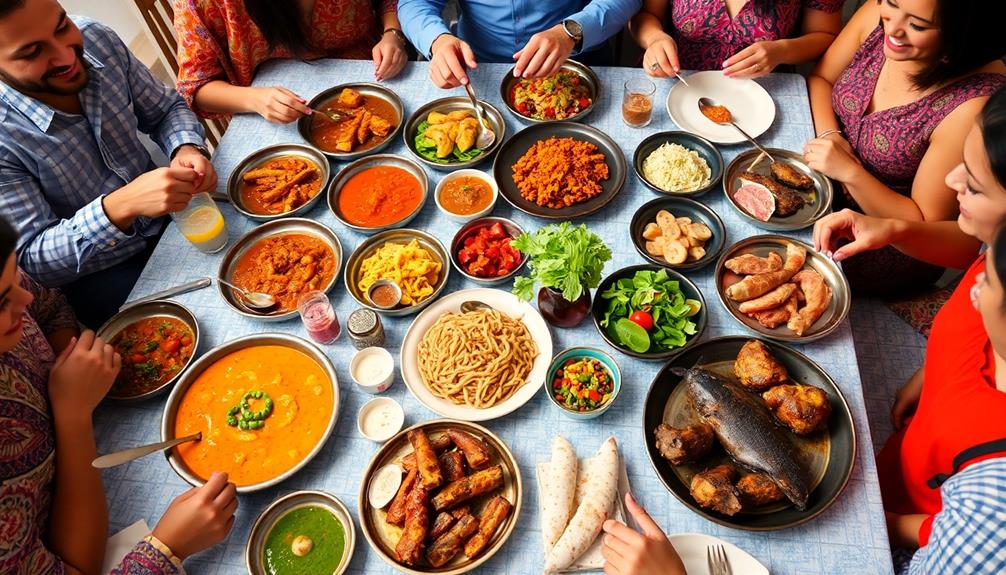
Your food preferences are often a reflection of your personality traits. If you're outgoing, you might lean towards fast foods and social dining experiences. Adventurous eaters tend to explore diverse and healthier options, while anxious individuals often stick to familiar, bland foods. Sweet treats might appeal to those who are more agreeable. Additionally, genetic factors and neurotransmitters like serotonin influence your cravings and food choices. Understanding these connections can offer insights into your eating habits and preferences. Keep exploring to uncover more fascinating links between your personality and what you love to eat.
Key Takeaways
- Personality traits like extraversion and conscientiousness significantly influence food preferences, impacting choices from fast food to healthier options.
- Genetic factors, such as the TAS2R38 gene, determine taste sensitivity and impact adventurousness in food exploration.
- Neurotransmitters like serotonin and dopamine affect mood and cravings, linking emotional states to food choices and preferences.
- Food neophobia and neophilia, driven by personality, influence dietary habits, with neophilic individuals tending to have healthier eating patterns.
- Cultural background and social norms shape food preferences, reflecting societal influences and gender expectations in dietary choices.
Personality Traits Overview

When it comes to personality traits and their influence on food preferences, you might find that certain characteristics shape your choices more than you realize. For instance, if you score high in extraversion, you're likely drawn to fast foods, ice cream, and chocolate, reflecting your sensation-seeking nature. Extraverts may also enjoy vibrant dishes like Mushroom Masala, which offer rich flavors that excite the palate.
On the other hand, individuals with high openness to experience often embrace a wider variety of foods, particularly adventurous and spicy cuisines.
Conversely, if you experience higher levels of neuroticism, you might notice a narrower range of food preferences. Anxious individuals frequently gravitate towards familiar and bland options, avoiding novel foods.
Your agreeableness can also play a role; those who score high here often prefer sweeter foods, while conscientious individuals typically lean towards healthier choices like vegetables, dairy, and nuts.
Understanding these personality traits can considerably enhance your dietary habits. Research suggests that recognizing how your traits influence food preferences can facilitate personalized nutrition strategies tailored to your lifestyle.
The Role of Sensory Perception
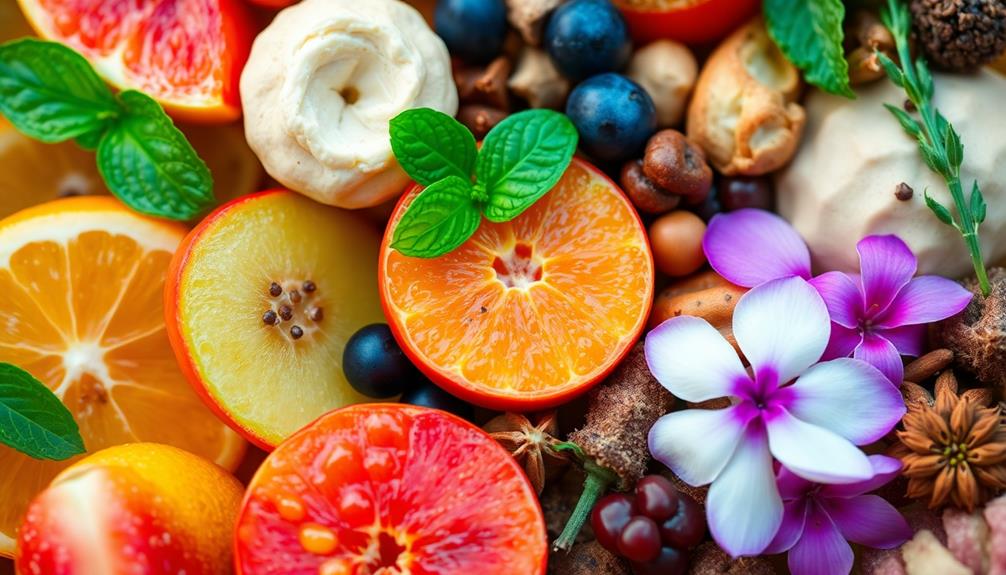
Your taste preferences can reveal a lot about your personality, shaped by both sensory perception and genetic factors.
For instance, if you're a supertaster, you might find certain bitter flavors off-putting, which could align with specific traits in your personality.
The rich flavors of dishes like Red-Braised Pork Belly may appeal to those who enjoy depth and complexity, while simpler flavors might attract those who prefer straightforward experiences.
Understanding how your genetic background influences what you enjoy eating can help you make more informed food choices.
Taste and Personality Traits
Taste buds aren't just receptors for flavor; they also serve as a window into your personality. Your food preferences can reveal a lot about your traits. If you're a sensation seeker, you might crave spicy, sour, or crunchy foods, embracing bold flavors that others shy away from.
For instance, a preference for dishes like Caruru might indicate an adventurous palate, as this dish combines diverse flavors and ingredients. On the other hand, if you tend to feel anxious, you could find yourself sticking to a narrower range of food choices, preferring familiar tastes.
Research shows that individuals with higher openness to experience are more likely to explore new flavors, showcasing adventurous eating habits. This connection between taste and personality is partly driven by neurotransmitters and hormones that influence your preferences.
Supertasters, who perceive bitterness more intensely, often report more food dislikes and can be linked to certain personality traits, including psychopathy. Conversely, those who favor sweet tastes tend to exhibit prosocial behaviors.
Understanding how your taste preferences align with your personality traits can offer insights into your eating habits and emotional responses to food. The interplay between taste and personality is a fascinating reminder of how deeply interconnected our senses and identities truly are.
Genetic Influence on Preferences
Although many factors shape our food preferences, genetic influences play an essential role in determining how we perceive flavors. Genetic factors, especially the TAS2R38 gene, categorize you as a supertaster, medium-taster, or non-taster, impacting your taste perception and food preferences.
As a supertaster, you might find bitter flavors overwhelmingly intense, leading to greater food avoidance behaviors compared to non-tasters who may be more adventurous with their diets. This genetic predisposition can also affect your affinity for certain cuisines, such as the preference for sweet flavors found in treats like Dorayaki (Red Bean Pancake), which are popular among many due to their delightful sweetness.
Research shows that your personality traits also intertwine with these genetic influences. For instance, if you score high on openness to experience, you're likely to consume more fruits and vegetables, reflecting a willingness to embrace diverse flavors.
Curiously, individuals with a preference for sweetness often exhibit prosocial behaviors, suggesting a deeper connection between taste preferences and psychological traits driven by genetics.
Additionally, sensory preferences, including texture and mouthfeel, are influenced by genetic variations. These factors notably inform your food choices and avoidance behaviors, making you a unique consumer in the marketplace.
Understanding the genetic roots of your taste perception can illuminate why you gravitate toward certain foods and steer clear of others.
Neurotransmitters and Food Choices
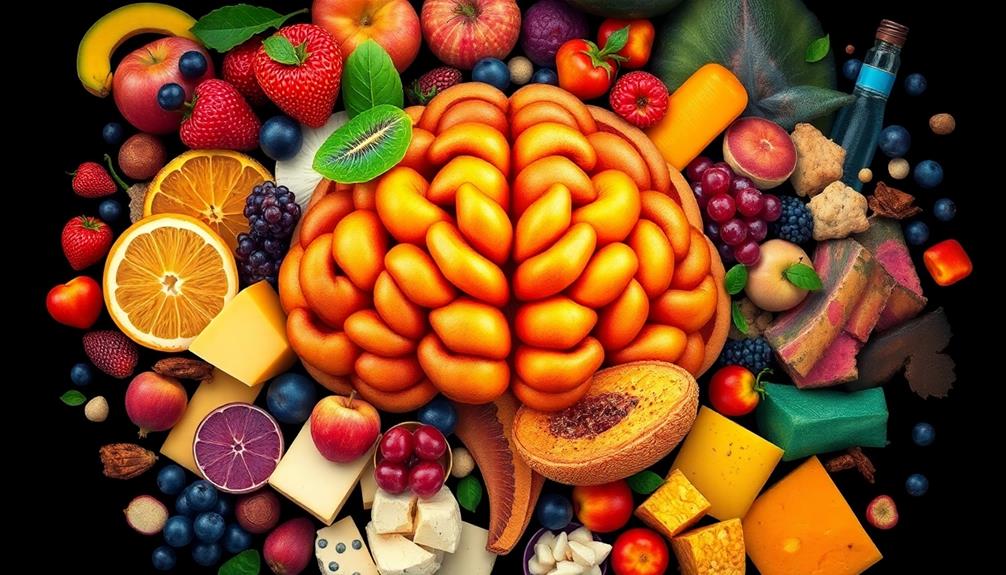
Your food choices are heavily influenced by neurotransmitters like serotonin and dopamine, which regulate your mood and cravings.
For example, the comforting flavors of dishes like Nettle and Potato Soup can be particularly appealing when you're feeling low, as they provide warmth and nourishment.
If you're feeling stressed or anxious, you might find yourself reaching for comfort foods high in sugar and fat, a response linked to your brain's reward system.
Understanding how these chemicals interact with your personality traits can help you make more informed dietary decisions.
Neurotransmitter Influence on Preferences
Neurotransmitters play an essential role in shaping your food preferences, influencing what you crave and enjoy. For instance, serotonin affects your desire for sweetness, while low serotonin levels can provoke cravings for salty and fatty foods. Similarly, dopamine sensitivity can alter your food reward response, impacting your overall choices.
| Neurotransmitter | Effect on Preferences | Associated Personality Traits |
|---|---|---|
| Serotonin | Cravings for sweet foods | Openness, agreeableness |
| Dopamine | Reward response to food | Conscientiousness, extraversion |
| Low Serotonin | Cravings for salty/fatty | Neuroticism |
| Imbalances | Emotional eating behavior | Various personality traits |
| High Dopamine | Enjoyment of diverse foods | Adventurousness |
Your dietary habits can reflect these neurotransmitter influences. For example, if you experience emotional eating, it's likely linked to neurotransmitter imbalances, shaping your cravings for comfort foods. Understanding the connection between neurotransmitters and your food choices can empower you to make healthier decisions and better appreciate your unique preferences.
Hormonal Effects on Choices
Hormonal variations frequently influence your food choices and cravings, often interacting with neurotransmitter levels to shape your preferences.
For instance, serotonin plays an essential role in mood regulation and appetite control. When your serotonin levels dip, you might find yourself reaching for carbohydrate-rich foods, as they can temporarily boost serotonin production and improve your mood. Notably, during special occasions like Halloween, people may gravitate toward themed treats, such as Graveyard Taco Dip, which can further influence their cravings and food choices.
On the other hand, ghrelin, known as the "hunger hormone," stimulates your appetite, pushing you toward high-calorie foods, especially if you have higher levels of neuroticism.
Stress also affects your choices; cortisol, the stress hormone, tends to increase cravings for sweet and fatty foods, making comfort foods more appealing during tough times.
Additionally, variations in hormones like insulin and leptin can disrupt satiety signals, leading to changes in your food preferences and overall eating behavior.
These hormonal effects highlight individual differences in how people respond to various foods based on their unique hormonal and neurotransmitter profiles. Understanding these hormonal influences can help you make more informed decisions about your eating habits and cravings.
Personality and Eating Behavior
Food choices often reflect deeper aspects of your personality, shaped by the interplay of neurotransmitters like dopamine and serotonin. These chemicals greatly influence your food preferences, linking them to various personality traits. For instance, those who enjoy Kue Putu might demonstrate a preference for sweet and comforting flavors, reflecting a warm and nurturing personality.
Here's how:
- Risk-Taking Behaviors: Higher dopamine levels may lead you to seek stimulating foods, reflecting a thrill-seeking personality.
- Taste Sensitivity: If you exhibit neuroticism, you might notice a narrower range of food preferences due to heightened taste sensitivity, causing anxiety around novel foods.
- Impulsivity: If impulsivity characterizes your personality, you may often find yourself reaching for quick, unhealthy options, despite knowing the health risks.
- Openness: Those with high levels of openness generally enjoy experimenting with diverse cuisines, showcasing a broader flavor perception.
Additionally, hormonal variations can affect your cravings, often linking emotional eating to stress sensitivity.
As you navigate your food choices, consider how these neurotransmitters and personality traits interplay within you. Understanding this connection can empower you to make more mindful decisions about what and how you eat.
Cultural Influences on Preferences

Cultural influences shape your food preferences in profound ways, often reflecting the values and beliefs of your society. Your cultural background plays a significant role in determining your dietary preferences, with traditional cuisines echoing collective values.
For example, dishes like Chilaquiles showcase how leftover ingredients can be transformed into delicious meals, embodying resourcefulness in Mexican cuisine. As globalization introduces diverse food options, you may find your culinary practices blending with various influences, leading to unique food choices.
Social norms also dictate what you eat. Festivals and rituals often encourage communal eating, reinforcing social bonds and shared experiences.
Gender expectations further impact your preferences; research shows men typically lean towards meat-heavy diets, while women often favor lighter meals rich in fruits and vegetables, shaped by societal health perceptions.
Moreover, cultural narratives link specific personality traits to particular food preferences, embedding these choices within broader societal contexts. For instance, adventurous eaters may be seen as more open-minded, while those who prefer comfort foods might be viewed as nurturing.
Ultimately, your food choices aren't merely personal; they reflect deeper cultural connections and the evolving landscape of dietary practices shaped by globalization and communal values.
The Psychology of Food Behavior
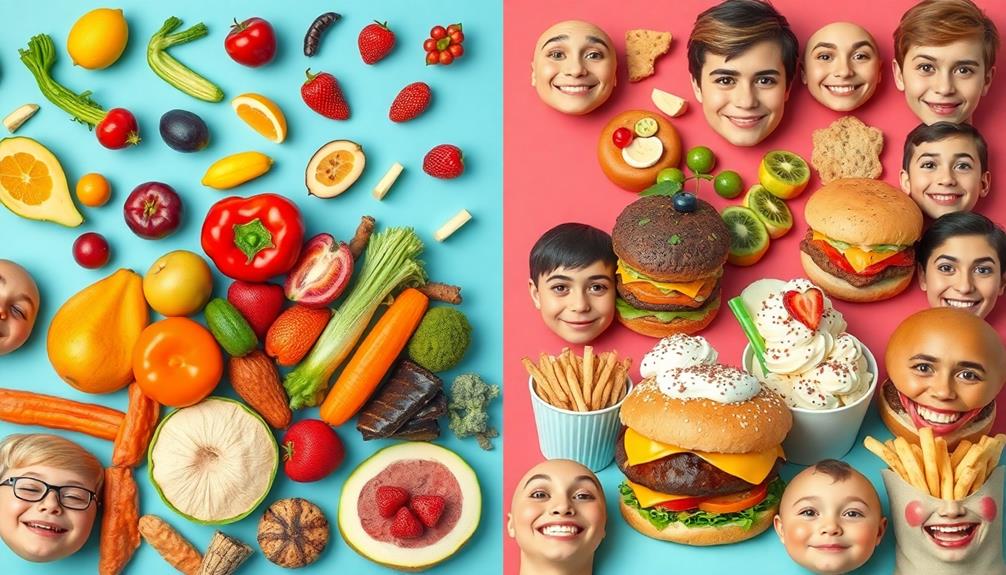
Your food choices are deeply intertwined with your personality, revealing insights into who you are. Understanding the psychology behind your food behavior can illuminate why you prefer certain dishes over others. For instance, if you enjoy rich and complex flavors, you may find yourself drawn to dishes like braised beef in Barolo wine, which reflects a preference for depth and tradition.
Here are some key connections between personality traits and food preferences:
- Extraversion: If you're outgoing, you might favor fast foods and social dining experiences.
- Openness: Those high in openness often explore diverse flavors and gravitate towards healthier options like fruits and vegetables.
- Neuroticism: Anxious individuals typically exhibit food aversions, leading to limited food choices and picky eating.
- Agreeableness: If you're agreeable, you're likely to enjoy sweet foods, reflecting your sociable nature.
Emotional states further interact with these traits; for example, stress can narrow your food preferences.
Sensation-seekers, on the other hand, tend to enjoy spicy, crunchy, or sour foods, craving stimulation. Cultural influences also play a significant role, shaping not just what you eat but how you feel about it.
Recognizing these patterns can help you understand your eating habits better and make more informed food choices.
Food Neophobia and Neophilia
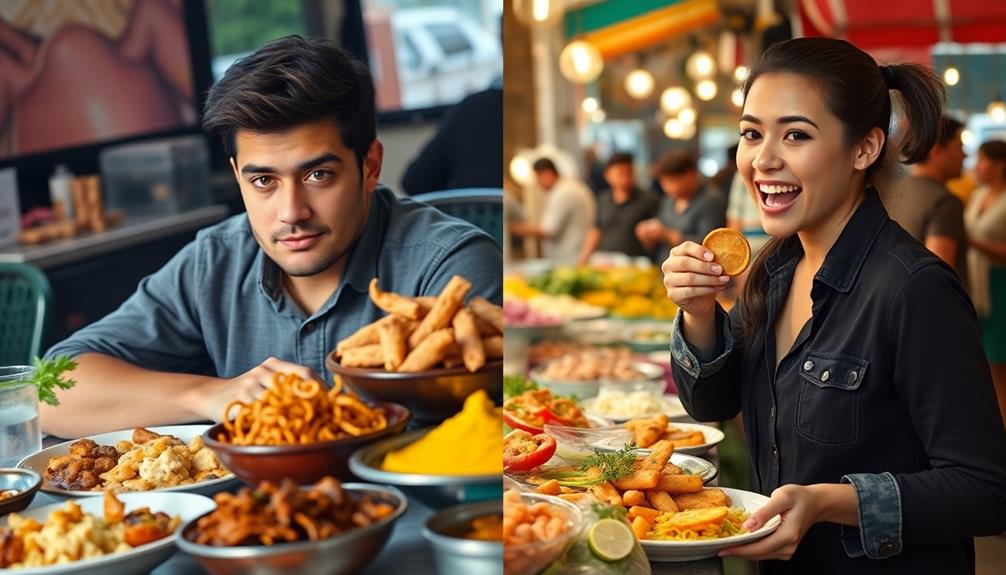
Many people experience varying degrees of food neophobia and neophilia, which can greatly influence their eating habits and overall health.
Food neophobia, characterized by a reluctance to try new foods, is often linked to personality traits like neuroticism and anxiety. This can lead you to stick with familiar options, potentially impacting your Body Mass Index (BMI) negatively.
In contrast, those who embrace food neophilia may find joy in exploring diverse cuisines, such as Korean BBQ, which offers a communal and interactive dining experience. These adventurous eaters are more likely to explore diverse flavors and cuisines, incorporating a variety of fruits and vegetables into their diets.
Research indicates that those with food neophilia generally exhibit healthier eating patterns and lower rates of obesity.
Understanding the dynamics of food neophobia and neophilia can inform dietary interventions aimed at promoting adventurous eating behaviors, especially in populations that show restrictive food preferences.
Implications for Future Research
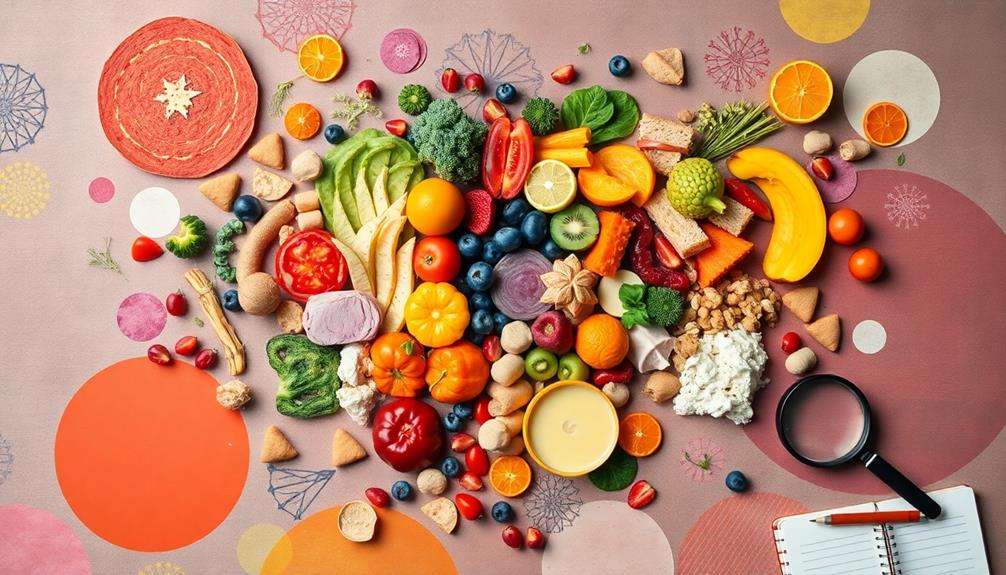
Understanding the implications for future research on personality and food preferences opens up exciting avenues for exploration.
By delving deeper into this relationship, you can uncover valuable insights that may transform dietary habits and nutritional strategies. Here are some key areas to reflect on:
- Personality Traits: Investigate how specific traits influence food neophobia and food neophilia, which can inform personalized nutrition approaches.
- Cultural Factors: Explore how cultural influences shape food preferences and personality traits across diverse populations, providing a broader understanding of dietary behaviors.
- Mood Fluctuations: Examine the bidirectional relationship between mood and long-term dietary habits to uncover connections between emotional well-being and food choices.
- Environmental Factors: Assess the impact of socioeconomic status and urban living on food preferences and how these factors may alter personality traits over time.
Frequently Asked Questions
What Is the Link Between Food and Personality?
You'll find that your personality influences your food choices. Extraverted folks often enjoy bold flavors, while those high in neuroticism might crave comfort foods. Openness can lead you to try adventurous dishes and diverse cuisines.
How Does Personal Preference Affect Food Choices?
Your palate's a canvas, painted by personal preference. It shapes what you crave, steering you towards comfort foods or daring flavors. Each choice reflects your tastes, experiences, and openness to culinary adventures, revealing who you are.
What Does Taste Preference Say About Personality?
Your taste preferences reveal a lot about your personality. If you enjoy adventurous flavors, you're likely open-minded. Sweet cravings suggest agreeableness, while a limited palate might indicate anxiety or a preference for familiarity.
Does Personality Influence Eating Styles and Food Choices?
Just like a painter chooses colors, your personality shapes your food choices. If you're adventurous, you'll explore diverse cuisines. If you're cautious, you'll lean towards healthier options. Your eating style truly reflects who you are.
Conclusion
Incredible as it may seem, your personality could be the secret ingredient to your food preferences! Just think about it: your quirks and traits might be steering you towards that spicy dish or keeping you rooted in comfort food. It's not just about taste; it's a wild dance between your senses, brain chemistry, and culture. So, next time you reach for that chocolate or kale, remember—your personality might just be the chef behind your cravings!
Nutrition
Why Certain Sounds Make Food Taste Better
By understanding how sound enhances flavor, you’ll uncover the secret to a more enjoyable dining experience that will leave you craving more.
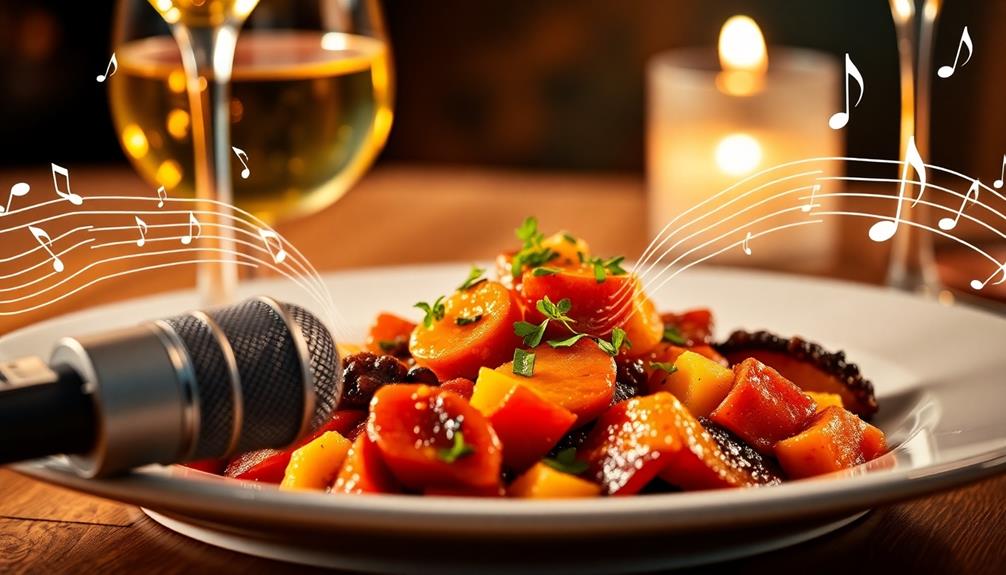
Certain sounds can make your food taste better because they enhance your overall experience. You probably notice that crunching or crackling sounds can amplify the perception of freshness and texture. Higher-frequency sounds often make foods, like chips, seem crisper and more enjoyable. The ambiance around you, including background music and noise, also influences flavor perception, elevating your enjoyment of the meal. When you hear satisfying sounds, your brain associates them with better taste experiences. So, if you're curious about how sound can transform your dining experience, there's plenty more to discover.
Key Takeaways
- Higher-frequency sounds enhance the perception of food crispness, making snacks taste fresher and crunchier.
- Auditory cues, like crunching sounds, stimulate taste receptors, amplifying flavor enjoyment during consumption.
- Background music influences flavor perception, with positive tunes enhancing food quality and overall dining experience.
- Noisy packaging and food sounds create expectations about texture and quality, improving the anticipation of taste.
- Cultural sound associations affect taste perceptions, highlighting the significance of familiar sounds in enhancing food enjoyment.
The Science of Sound and Taste
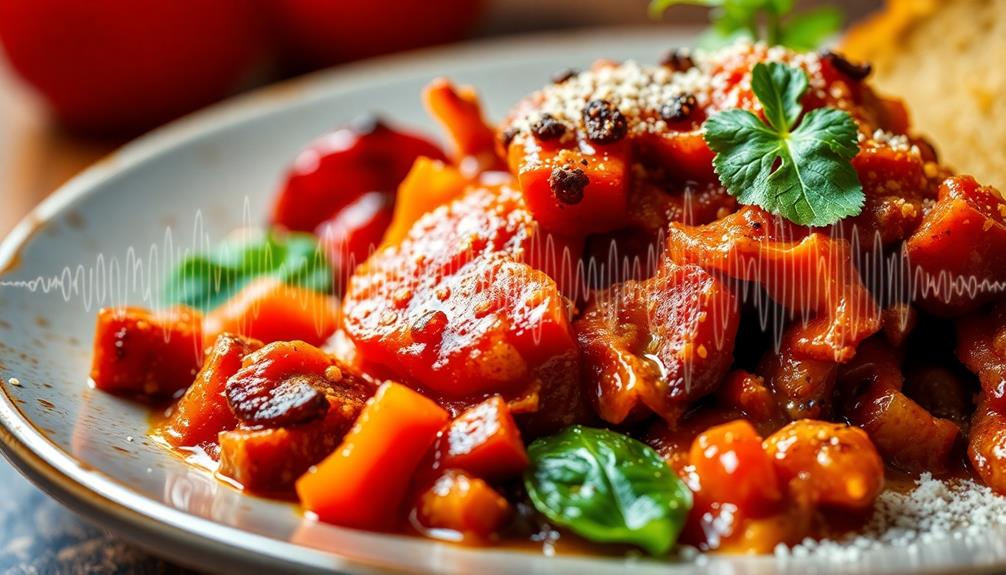
The connection between sound and taste might surprise you, but research reveals that our auditory experiences can greatly influence how we perceive flavors. For instance, studies led by Prof. Charles Spence show that higher-frequency sounds, specifically those above 2 kHz, enhance your perception of food crispness. When you munch on noisier Pringles crisps, you're likely to rate them as 15% fresher and crisper compared to quieter ones.
This phenomenon can be particularly noticeable during festive gatherings, such as when enjoying Graveyard Taco Dip at Halloween parties, where the crunch of tortilla chips adds to the overall enjoyment.
The sounds associated with eating—like crunching and crackling—serve as essential cues that your brain uses to interpret texture, which directly affects your taste perception. Additionally, background noise and music can change how intense you find flavors; positive sounds can enhance your enjoyment, while negative sounds can detract from it.
This integration of sound and taste happens automatically in your brain, where specific sounds can even evoke emotional responses that influence how you enjoy food. By manipulating soundscapes in dining settings, restaurants can improve how fresh and high-quality you perceive the food, leading to greater customer satisfaction.
Ultimately, the science of sound and taste highlights how intertwined your senses truly are.
How Sound Affects Flavor Perception
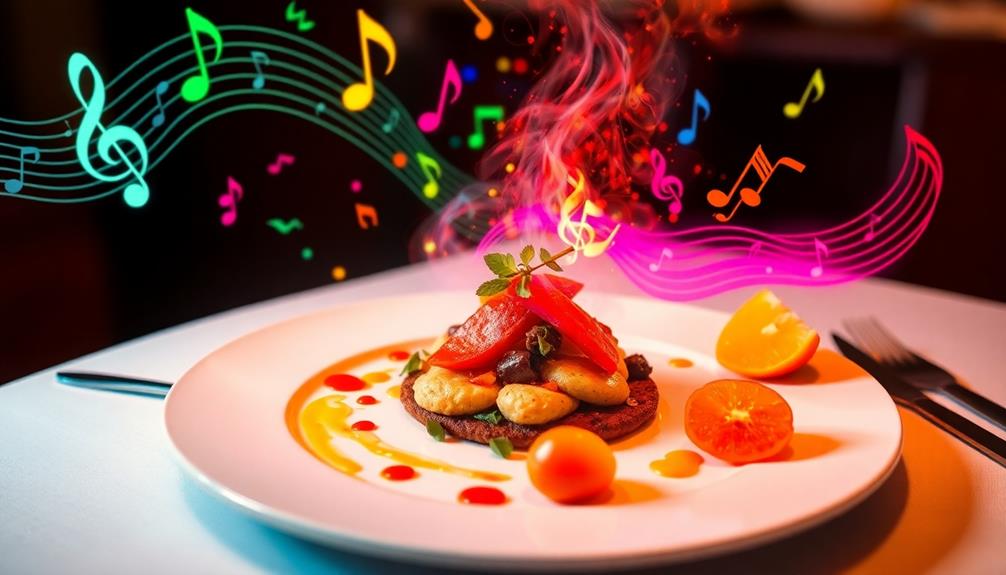
Sound greatly shapes how you perceive flavors, influencing everything from the enjoyment of a crunchy snack to the sweetness of a dessert. Research shows that auditory cues play an essential role in modulating your taste experience.
For instance, the satisfying crunch of Red-Braised Pork Belly can enhance the overall perception of flavor. Here are some key points to take into account:
- Higher-frequency sounds enhance perceived crispness.
- Noisy food packaging is designed to improve your eating experience.
- Background noise can alter your taste perceptions.
- Emotional responses triggered by sounds influence flavor enjoyment.
For example, louder crunching sounds from potato chips can make them seem 15% fresher than quieter ones.
Additionally, the sounds of food packaging greatly affect your perception of texture, creating a more enjoyable experience. Background noise can either elevate or diminish your enjoyment; pleasant sounds may boost flavor intensity, while excessive noise can make sweet and salty flavors less pronounced.
The Role of Auditory Cues
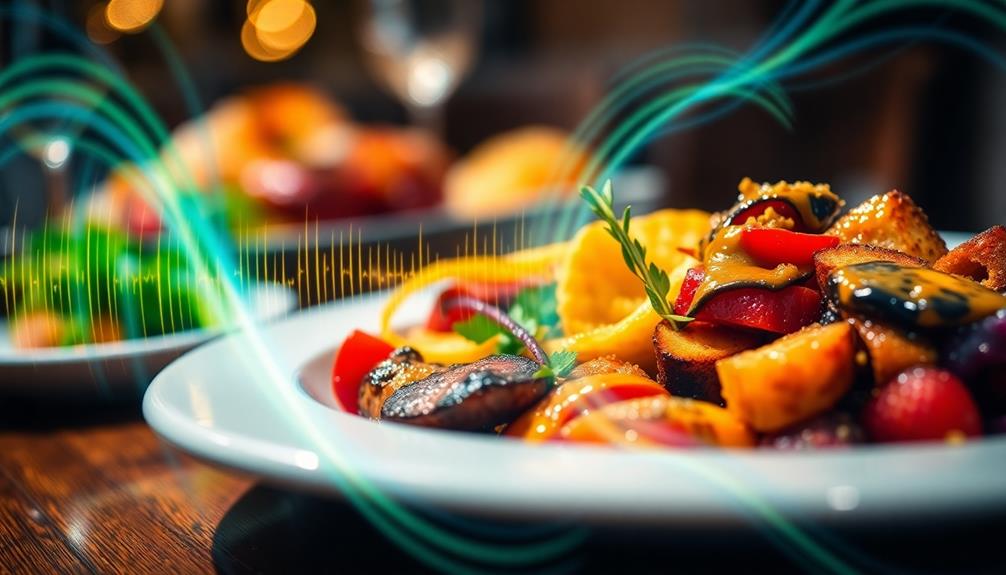
Often overlooked, auditory cues play an essential role in how you experience food. For instance, the satisfying crunch of loaded baked potatoes can enhance your perception of their freshness and quality. When you crunch into a chip, that satisfying sound can greatly enhance how fresh and high-quality you perceive it to be.
Research shows that louder crunching makes chips seem about 15% crunchier, influencing your enjoyment (Spence & Zampini, 2008). Additionally, the pitch of sounds can affect your taste perception; higher-pitched sounds are linked to sweetness, while lower-pitched ones can amplify bitterness (Kantono et al., 2016).
Background music or sounds also shape your eating experience. Positive auditory environments can elevate flavor ratings, while negative sounds can detract from enjoyment (Knoeferle et al., 2020).
Furthermore, the sound of food packaging can set your expectations; manufacturers often design packaging to create appealing sounds that enhance perceived crispness (Lerma & Buiatti, 2017).
Sound and Texture Interactions
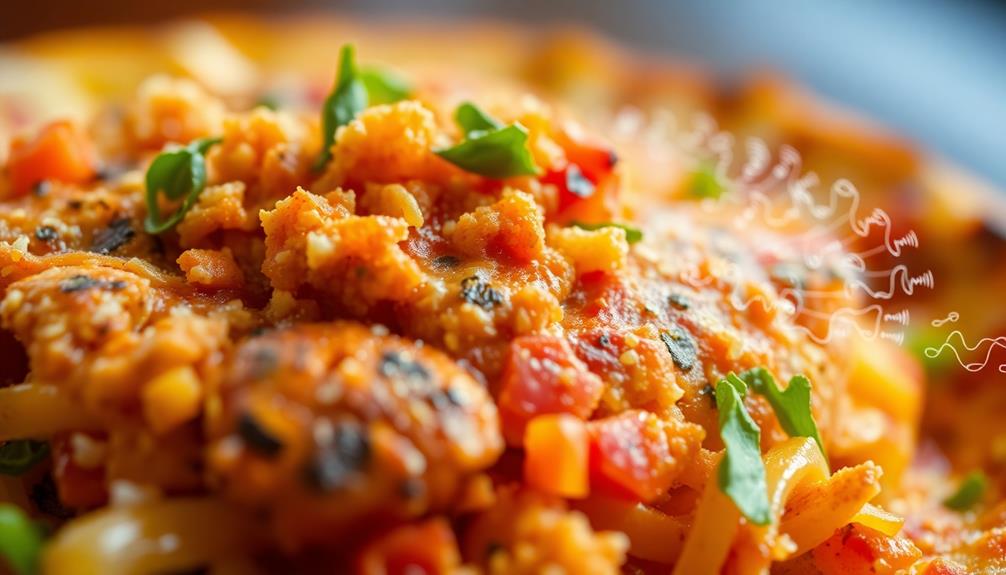
When enjoying crispy foods, you mightn't realize how much the accompanying sounds influence your perception of texture. The crunch of a potato chip or the crackle of a fried snack plays an essential role in how fresh and crispy you perceive it to be. Higher frequency sounds, specifically those above 2 kHz, can enhance your experience, making those textures seem even more delightful.
Just like the satisfying crunch of chilaquiles, the auditory experience contributes to how we enjoy our food.
Consider these key aspects of sound and texture interactions:
- Noisier chips are rated 15% crunchier than quieter ones.
- The crinkling of packaging can alter your perception of food quality.
- Sounds like crunching provide critical information about texture.
- Auditory cues can stimulate taste receptors, enhancing overall enjoyment.
This relationship between sound and texture isn't just a coincidence; it's a carefully crafted experience. Manufacturers even design noisier packaging intentionally to enhance your anticipation and enjoyment.
Research Findings on Sound's Impact
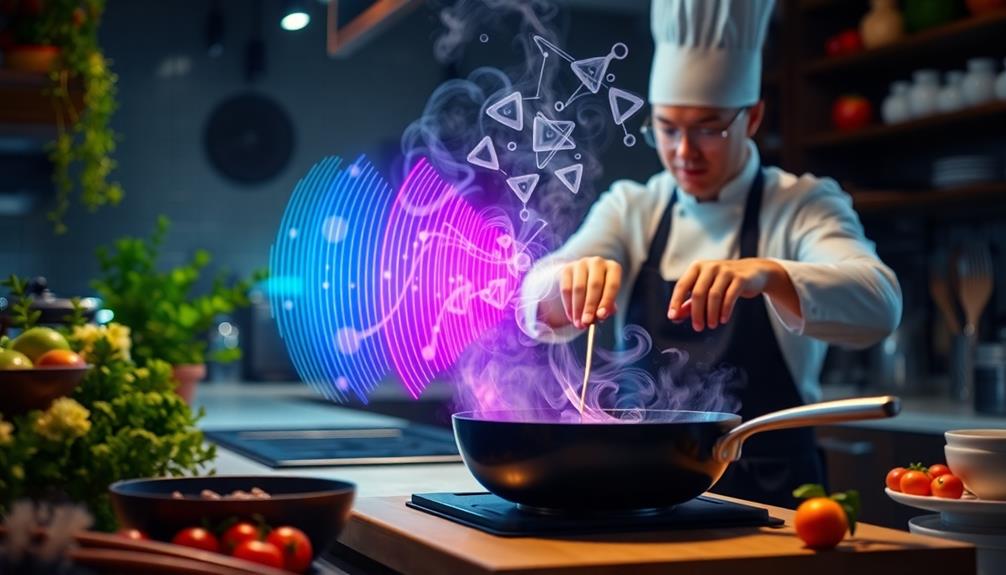
Recent studies reveal just how profoundly sound affects our food experiences, transforming our perceptions of freshness and flavor. Research conducted by Prof. Charles Spence found that participants rated noisier Pringles crisps as 15% fresher and crisper than their quieter counterparts. This highlights how sound plays a significant role in how you perceive food tastes, similar to how the creamy texture of nettle soup can enhance your overall enjoyment of a dish.
Moreover, higher frequency sounds, particularly those above 2 kHz, enhance your perception of crispness in foods, showing a direct link between sound pitch and texture perception. Notably, the sound of food packaging can also influence how crisp you think snacks are. Manufacturers have even begun designing noisier packets to enhance your eating experience.
It doesn't stop there; background noise impacts your flavor intensity ratings. While white noise can diminish your flavor enjoyment, positive sounds can enhance it, indicating that auditory context is significant during food consumption.
Additionally, sound influences the perception of carbonation in fizzy drinks, suggesting that adjusting sound could enhance taste experiences, especially beneficial for those with declining taste and smell capabilities.
Practical Applications in Dining
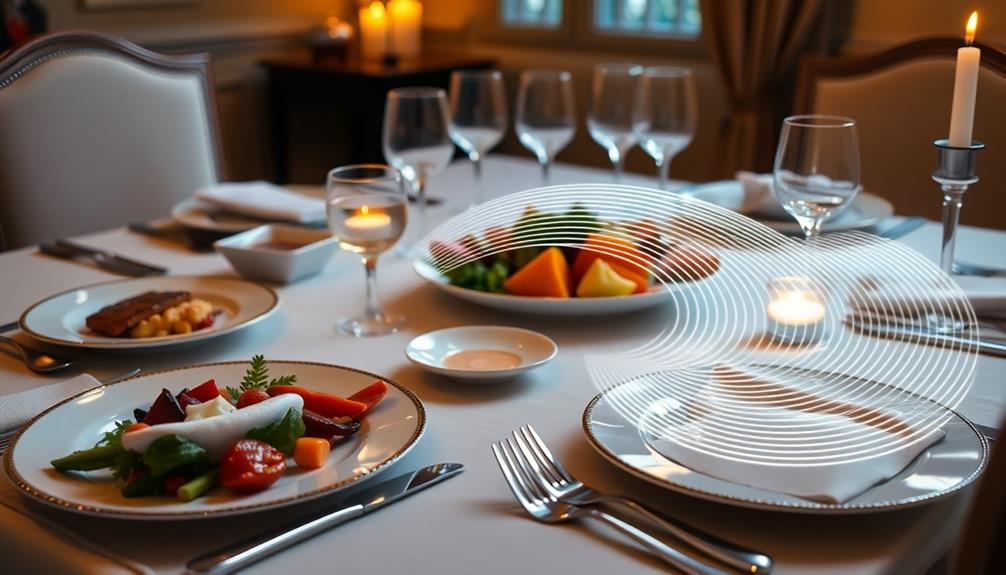
In the world of dining, the right sounds can elevate your experience considerably, turning an ordinary meal into a memorable event.
For instance, when enjoying traditional Brazilian dishes like Caldeirada, the combination of rich flavors and the right soundscape can enhance the overall enjoyment of the meal.
By understanding how background sound influences your perception of food and drink, restaurants can create an environment that enhances your dining satisfaction.
Here are some practical applications:
- Tailored Soundscapes: Match the audio to your menu theme, creating an immersive atmosphere.
- Volume Adjustments: Use louder sounds for crunchy items to enhance their freshness perception while keeping softer music for sweeter dishes.
- Strategic Music Selections: Choose background music that aligns with the cuisine to subconsciously influence drink and food choices.
- Positive Auditory Environments: Design soundscapes that promote a sense of quality, leading to increased customer loyalty and sales.
Music's Influence on Food Enjoyment
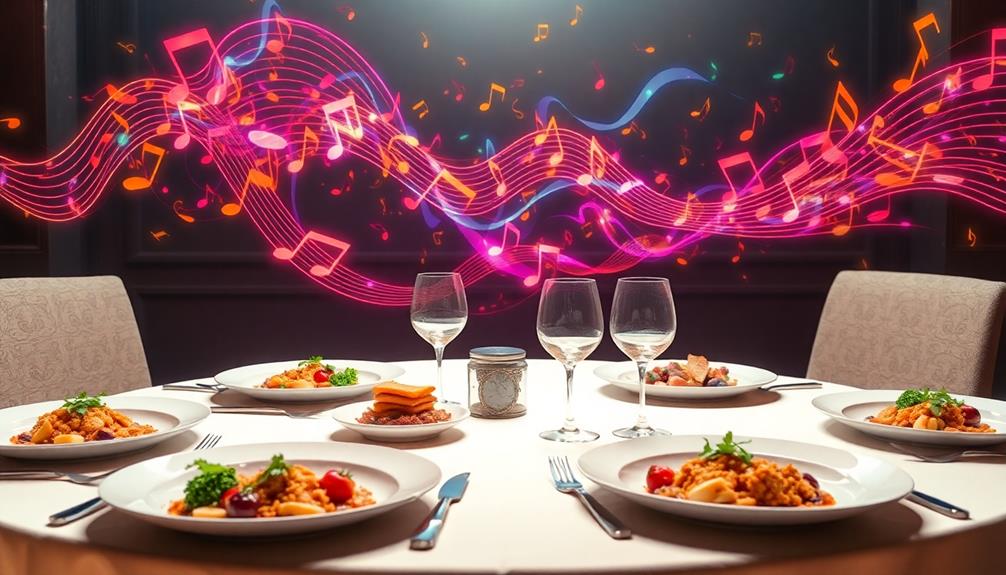
When you sit down to enjoy a meal, the background music you choose can greatly shape how you perceive flavors.
For instance, the rich spices of a Mushroom Masala can be complemented by soft, melodic tunes, enhancing the earthy mushroom flavor.
Studies show that different genres and tempos not only affect your taste experience but also influence your emotional responses to the food.
Sound and Flavor Perception
Amid the clinking of cutlery and the murmur of conversation, the role of background music in dining emerges as an essential element that can elevate your culinary experience. Research shows that auditory cues influence how you perceive flavor, transforming an ordinary meal into a delightful event.
For instance, enjoying traditional dishes like Horiatiko Psomi alongside uplifting music can enhance both the taste and the overall dining atmosphere. Here are some key aspects to reflect on:
- Positive tunes enhance your perception of food quality.
- Different music genres can alter your flavor ratings.
- Higher-pitched sounds make you perceive sweetness, while lower pitches amplify bitterness.
- Curated sound environments can revolutionize your dining enjoyment.
Imagine enjoying a dish while listening to the soothing sound of the sea; it might just enhance your appreciation of fresh seafood. The integration of these sounds creates expectations that modify how you taste your food.
For instance, a lively soundtrack can make a meal feel more enjoyable, while a slow ballad might lead you to savor each bite more thoughtfully. By being mindful of the auditory cues surrounding your meal, you can greatly enhance your overall dining experience and satisfaction.
Impact of Background Music
Background music transforms your dining experience, creating an atmosphere that can greatly heighten food enjoyment. Research shows that positive background music improves food quality ratings and overall dining experiences.
Different genres can even alter how you perceive the taste profile of your meal, impacting flavor intensity and enjoyment levels. For instance, if you're enjoying French cuisine while listening to French music, you might find the flavors more delightful. Similarly, enjoying a dish like Dorayaki (Red Bean Pancake) while listening to traditional Japanese music could enhance the overall experience.
Moreover, the volume of background music plays an essential role in your perception. Studies indicate that louder music can enhance the crunchiness of your food but may diminish the flavors of salt and sugar. This means that the right balance is vital for the enhancement of enjoyment during your meal.
On the flip side, excessive background noise—like chatter in a bustling restaurant—can distract you from fully savoring your food, leading to reduced flavor intensity and overall satisfaction.
Restaurants that strategically select background music not only elevate their customers' experiences but also potentially boost sales. So, next time you dine out, pay attention to the music; it might just make your meal taste even better.
Emotional Responses to Sound
Music has the power to transform your meal into a memorable experience, greatly enhancing your enjoyment of food. The right auditory cues can evoke emotional responses that elevate your dining experience. For instance, the sounds of sizzling meats or boiling stews can remind you of traditional dishes like Muamba De Galinha, creating a deeper connection to cultural flavors.
Here's how music influences your perception of flavors:
- Positive tunes boost enjoyment and perceived food quality.
- Specific genres can alter how you taste different dishes.
- Background music creates expectations that shape flavor perceptions.
- Crunchy sounds enhance the sensation of freshness.
Studies show that pleasant sounds lead to positive emotional reactions during meals (Kantono et al., 2016). The emotional impact of music directly links auditory stimuli to your taste experiences (Wang et al., 2017).
Additionally, background sounds can set the mood, influencing how you savor each bite (Spence, 2015). When you hear loud crunch sounds, for example, it increases your perception of food freshness, linking those auditory cues to your overall satisfaction (Zampini & Spence, 2004).
Ultimately, the interplay between sound and food can evoke cherished memories, further enriching your dining experience (Knoeferle et al., 2020).
Cultural Variations in Sound Perception
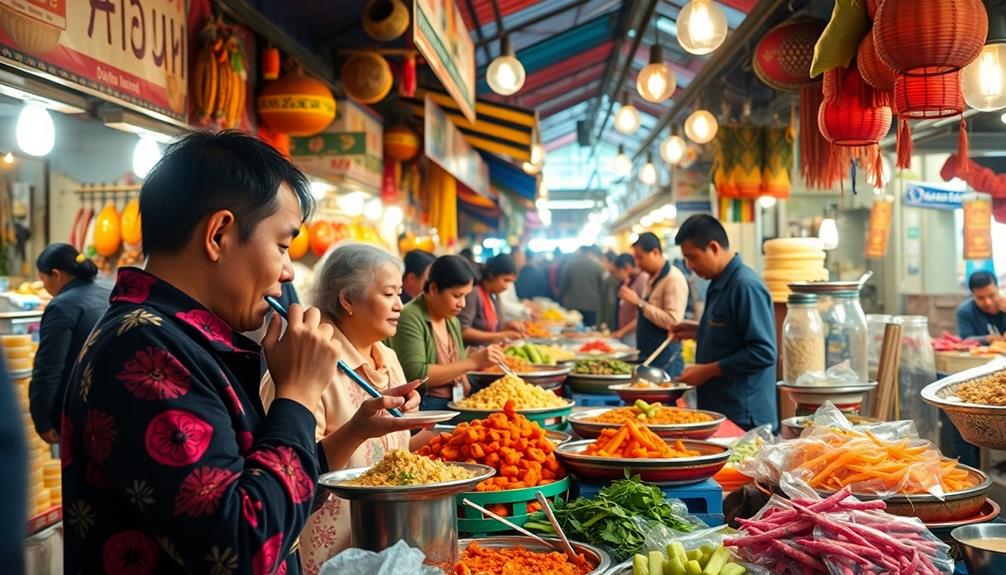
When you think about how sound affects your food experience, cultural influences play a huge role.
Different regions have unique musical preferences that can shape your taste perceptions, making certain flavors stand out more than others.
Understanding these sound associations across cultures helps uncover why your dining experiences might vary so much from someone else's.
Sound Associations Across Cultures
Cultural variations in sound perception play an essential role in how we experience food, shaping our enjoyment of flavors through unique auditory associations. You might be surprised to learn that different cultures can link specific sounds to particular tastes.
For example:
- High-pitched sounds may evoke sweetness in some cultures.
- Lower-pitched sounds can enhance the perception of bitterness.
- Classical music might elevate the quality perception of wine.
- Cross-modal correspondence between sound and taste varies widely across cultures.
These sound associations greatly impact food enjoyment, influencing how you perceive flavors. While the connection between sound and taste is universal, the specific associations you make can differ dramatically based on your cultural background.
This means that what enhances your culinary experience mightn't hold true for someone from another culture. As research continues to explore these cultural sound-food pairings, you may uncover even more ways that auditory cues shape your dining experiences.
Embracing these diverse perspectives can enrich your culinary journey, allowing you to appreciate the intricate relationship between sound and taste in various gastronomic contexts.
Regional Music Preferences
Regional music preferences greatly shape how you experience food, as different genres resonate uniquely with various cuisines. When you dine, the sound of music plays a vital role, influencing your perception of flavors and even your emotional responses.
For instance, studies show that playing French music in British supermarkets boosts sales of French wines, proving that cultural sound associations can impact food choices.
Your enjoyment of dishes can markedly vary based on the familiar sounds that align with your cultural background. If you're listening to upbeat salsa while enjoying a spicy taco, the lively rhythm enhances the overall experience. Conversely, playing somber classical music mightn't elevate your enjoyment of a hearty stew.
As ongoing research investigates deeper into the cultural aspects of sound perception in food contexts, it becomes clear that tailoring auditory cues can enhance culinary experiences across diverse populations.
The right music can elevate your meal, transforming it from just food into a memorable event. So, next time you sit down to eat, consider how the sounds around you might enhance—or detract from—your dining experience.
Future Research Directions in Sensory Studies
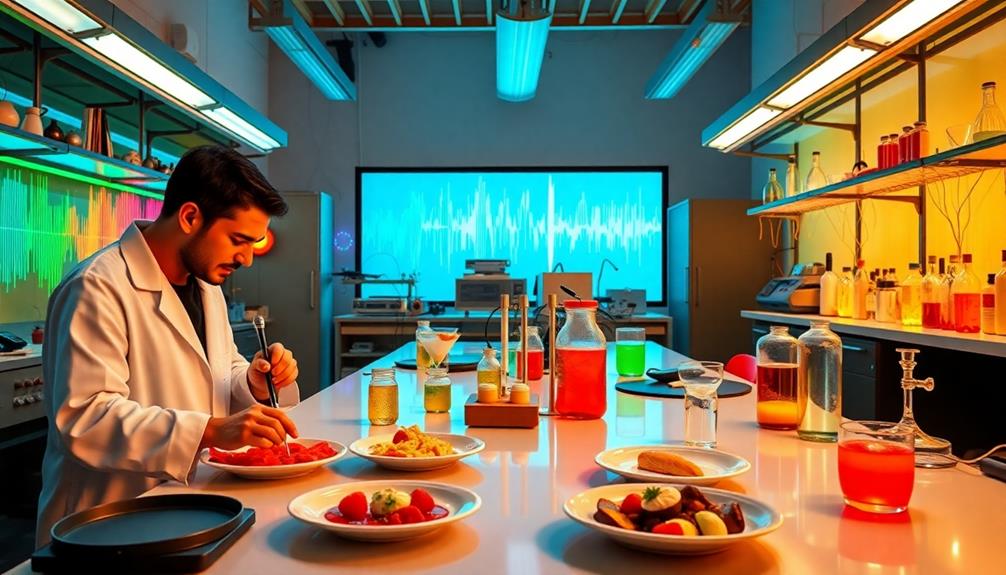
The future of sensory studies holds exciting potential for exploring how sound impacts taste perception and enjoyment. As you dive deeper into this fascinating field, consider the following research directions that could redefine how food makes you experience flavors:
- Investigate the varying effects of different sound types beyond white noise on taste perception.
- Quantify the impact of sound frequencies on specific taste profiles to enhance understanding of sound-taste interactions.
- Explore individual differences in sound perception and how they influence food enjoyment, aiming for personalized dining experiences.
- Foster collaborations between sensory scientists and culinary experts to develop innovative sound-based marketing strategies.
Future research could reveal intricate connections between sound and taste, shedding light on how auditory stimuli can enhance your enjoyment of food.
Longitudinal studies will be essential in evaluating the lasting effects of sound on your food preferences and consumption habits. By examining these elements, you can gain insights into how specific sounds can elevate your culinary experiences, ultimately transforming how you enjoy meals.
Embracing these directions won't only enhance your understanding but also pave the way for groundbreaking innovations in the food industry.
Frequently Asked Questions
Can Sounds Make Food Taste Better?
Absolutely, sounds can enhance your food experience. When you hear appealing crunches or pleasant background noise, it can elevate your perception of freshness and quality, making each bite more enjoyable and satisfying for you.
How Does Sound Affect the Taste of Food?
Sound affects your taste by altering perception. Higher pitches can make foods taste sweeter, while lower tones emphasize bitterness. Crunchy sounds enhance texture, making snacks feel fresher and more enjoyable during your eating experience.
Does Food Taste Better When It's Quiet?
Studies show that increased background noise can reduce your perception of sweetness by up to 25%. When it's quieter, you're likely to enjoy your meal more, experiencing flavors without distractions that mask their true taste.
What Is It Called When Sound Affects Our Sense of Taste?
When sound affects your sense of taste, it's called "cross-modal correspondence." This phenomenon shows how different sensory experiences interact, influencing how you perceive flavors and enhancing your overall enjoyment of food.
Conclusion
In the grand symphony of dining, sound acts as the conductor, guiding your taste buds through a harmonious experience. When you savor a dish, remember that each crunch and pop dances with the flavors, elevating your meal to a masterpiece. As you explore new culinary landscapes, let the melody of sound enhance your journey, transforming ordinary bites into unforgettable moments. Embrace this sensory interplay, and you'll discover that food, much like music, is a vibrant tapestry woven with taste and sound.
Nutrition
How Jet Lag Affects Our Food Choices
Curious about how jet lag influences your cravings and eating habits? Discover the surprising effects on your food choices and well-being.
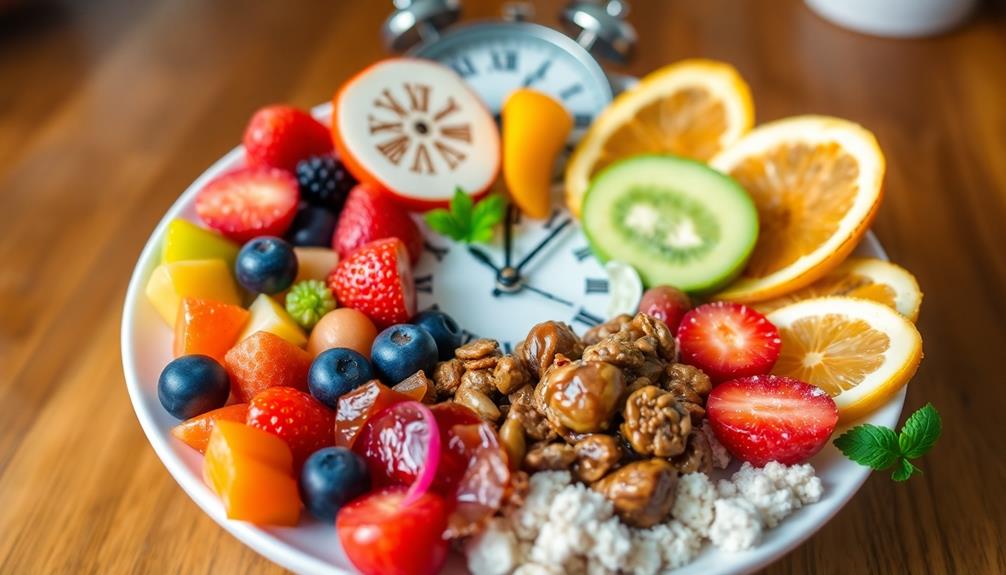
Jet lag disrupts your internal clock, leading to cravings for unhealthy foods and irregular eating patterns. When you travel across time zones, your body struggles with meal timing, causing delayed meals or impulsive snacking. This shift often triggers increased ghrelin levels, making you crave high-calorie comfort foods, especially at night. As a result, you're more likely to indulge in sugary drinks and unhealthy snacks. Plus, poor dietary choices negatively impact your gut health and overall well-being. By understanding these effects, you can better navigate your food choices during and after travel. There's more to explore on how to manage these challenges effectively.
Key Takeaways
- Jet lag disrupts circadian rhythms, leading to irregular meal timings and impulsive food choices.
- Increased ghrelin levels during jet lag drive cravings for high-calorie, energy-dense foods.
- Poor dietary quality often results from convenience-based food choices during jet lag.
- Disrupted gut microbiome balance from jet lag can lead to unhealthy food cravings and obesity risks.
- Aligning meal times with the destination's time zone enhances recovery and promotes better food choices.
Understanding Jet Lag

Jet lag hits when you cross multiple time zones, throwing your body's internal clock out of sync with the new environment. This misalignment disrupts your circadian rhythms, which regulate your sleep-wake cycles. As a result, you might experience fatigue, low mood, and cognitive impairments like brain fog. The recovery can take one day for each time zone crossed, with westward travel often being easier to adjust to than eastward.
Your internal circadian system relies heavily on consistent meal timing to maintain balance. When you travel, irregular food choices can further disrupt your biological clock. For instance, indulging in rich and spicy dishes like Mushroom Masala or opting for comforting desserts such as Rasgulla at odd hours can lead to gastrointestinal issues, compounding the already challenging symptoms of jet lag.
As you navigate this adjustment, it's essential to be mindful of how your meal timing aligns with the local schedule.
Moreover, age factors into this complexity; older individuals may struggle more with jet lag, making recovery tougher. Understanding how jet lag affects your body helps you make better choices. Prioritizing regular meal times can help mitigate the symptoms and allow for a smoother shift into your new environment.
Definition of Social Jet Lag

Social jet lag occurs when your sleep patterns shift considerably between weekdays and weekends, often resulting in a weekend sleep midpoint that's 1.5 hours or more later than your weekday schedule. This phenomenon is particularly common among young adults and those with natural late sleep cycles.
In fact, about 40% of people experience social jet lag, though only 16% recognize it in themselves. The disruption of sleep and wake times impacts your circadian rhythms, which can lead to irregularities in your body's natural clock.
Modern lifestyle factors, like electric lights and blue-light screens, exacerbate this issue, making it harder for you to maintain a consistent sleep schedule. As a result, those dealing with social jet lag often show poorer dietary intake. You might find yourself consuming fewer plant-based foods and opting for unhealthy choices like fries and sugary drinks.
Incorporating more seasonal dishes like Nettle and Potato Soup can help improve your nutrition and overall well-being. This irregularity in sleep patterns can also contribute to a poor gut microbiome composition, which is linked to health risks such as obesity and inflammation.
Risks of Social Jet Lag

Experiencing social jet lag can greatly impact your health, particularly concerning your dietary choices. When your internal clock is misaligned with your daily schedule, you're likely to adopt poor eating patterns. This often leads to higher caloric intake, skewed meal times, and an increase in unhealthy food options.
| Effects of Social Jet Lag | Nutritional Impact |
|---|---|
| Delayed first meal | Decreased plant-based foods |
| Increased ghrelin levels | Higher cravings for junk food |
| Disrupted eating frequency | Higher average calories consumed |
Your hunger hormone, ghrelin, spikes in the evening, making you crave energy-dense foods, which can exacerbate the problem. You might notice that your meals consist primarily of fries and sugary drinks rather than nutritious options. Additionally, social jet lag can lead to an unfavorable gut microbiome, which is linked to inflammation and obesity. This combination of factors not only affects your immediate well-being but also poses long-term health risks. Being aware of these consequences can help you make better food choices and mitigate the effects of social jet lag on your diet.
Impact on Gut Health

When you experience social jet lag, your gut bacteria can change in ways that may harm your health.
Disrupted circadian rhythms can lead to poor dietary choices, making you crave unhealthy foods, such as those high in sugar and processed ingredients.
Incorporating nourishing options like Yekolo (Roasted Barley) can help counteract these cravings.
Gut Bacteria Composition Changes
Jet lag can greatly alter the composition of your gut bacteria, which plays an essential role in your overall gut health. When you experience social jet lag, the balance of your gut microbiome shifts unfavorably.
Studies show that individuals in this category tend to harbor certain gut bacteria linked to obesity and inflammation. These changes often coincide with poor dietary habits, like consuming fewer plant-based foods and opting for unhealthy options. Just as traditional dishes like Red-Braised Pork Belly highlight the importance of rich flavors, your food choices during jet lag can similarly impact your well-being.
In the evenings, you might notice an increase in the hunger hormone ghrelin, driving your appetite for energy-dense foods. This heightened craving can lead to further disruptions in your eating patterns.
The impact of social jet lag extends to your metabolic processes as well, as a disrupted circadian rhythm creates a cycle that perpetuates this imbalance.
To combat these adverse effects, it's vital to establish consistent sleep-wake patterns. Doing so can help improve your gut health and dietary choices, allowing your gut microbiome to recover and function effectively.
Circadian Rhythm Disruption
Circadian rhythm disruption considerably impacts gut health by altering the delicate balance of your microbiome. When you experience social jet lag, it can lead to an unfavorable gut microbiome composition. This means that bacteria linked to obesity and inflammation become more prevalent, affecting your overall gut health.
You might notice that your appetite changes as well; increased levels of the hunger hormone ghrelin in the evening can make you crave energy-dense foods, pushing you toward unhealthy choices. For instance, just as Brazilian cuisine features a variety of hearty and flavorful dishes like Caldeirada that provide nourishment, a balanced diet can help support your gut health.
Your meal timing plays a vital role here. Irregular eating patterns can worsen the internal misalignment that affects your gut microbiota. Studies show that those dealing with social jet lag often have poorer diet quality, consuming fewer plant-based foods while indulging more in fried foods and sugary drinks.
This doesn't just impact your waistline; it also disrupts metabolic regulation. To improve gut health, try to establish consistent sleep-wake patterns and align your meal timings with your biological clock.
Even slight adjustments can make a significant difference in your gut health, helping you feel better and make healthier food choices.
Dietary Choices and Health
Social jet lag doesn't just mess with your sleep; it also takes a toll on your dietary choices and overall health. When your circadian rhythms are disrupted, your gut microbiome can suffer, leading to serious health risks.
For instance, consuming traditional Italian dishes like Agnolotti made with fresh ingredients can provide essential nutrients that support gut health.
Here are three ways social jet lag impacts your nutrition:
- Poor Food Quality: You may find yourself reaching for unhealthy options like fried foods and sugary drinks instead of nutrient-rich, plant-based foods. This shift can negatively impact your gut health.
- Irregular Eating Patterns: With delayed first meals and less frequent eating, your gut microbiome struggles. This can create an imbalance, making you more susceptible to obesity and inflammation.
- Increased Hunger Hormones: Disrupted circadian rhythms can elevate ghrelin levels in the evening, ramping up your cravings for energy-dense foods. This leads to unhealthy snacking and poor nutritional choices.
Maintaining consistent sleep-wake patterns is essential for improving your gut health and making better dietary choices.
Sleep Deprivation and Diet

When you don't get enough sleep, your appetite can go haywire, leading you to crave unhealthy foods.
This change in food choices often results in overeating and poor nutrition that can spiral into other health issues.
For instance, the desire for comforting foods like scalloped potatoes may increase due to sleep deprivation.
Understanding this connection between sleep deprivation and diet is key to making better choices for your well-being.
Sleep's Influence on Appetite
Sleep deprivation considerably disrupts your appetite and food choices, often leading to unhealthy eating patterns. When you don't get enough sleep, your body craves high-calorie foods, which can increase your calorie consumption the next day.
This cycle of poor food choices becomes particularly problematic if you're experiencing jet lag or irregular sleep patterns. For instance, during festive occasions, such as Halloween, people may be tempted to indulge in unhealthy treats like Graveyard Taco Dip and other sugary snacks, further exacerbating the effects of sleep deprivation.
Here are three key effects of sleep deprivation on your diet:
- Increased Calorie Consumption: Studies show that lack of sleep can result in overeating, as your body seeks quick energy sources in the form of calorie-dense foods.
- Delayed Meal Times: If you're dealing with social jet lag, your meal times may shift, leading to less frequent eating. This irregularity contributes to poor dietary quality, as you're likely to choose more convenient, unhealthy options.
- Improved Eating Habits with More Sleep: Even gaining an extra hour of sleep can positively impact your appetite and food choices, showing a direct link between sleep and nutrition.
Impact on Food Choices
Jet lag and irregular sleep patterns can have a significant impact on your food choices. When you experience poor sleep, your eating habits often suffer. Research shows that sleep deprivation leads to increased calorie consumption, especially high-calorie foods. This is particularly problematic for those dealing with social jet lag, as they tend to have poorer dietary choices, opting for unhealthy options like fries and sugary drinks.
Here's how sleep affects your food choices:
| Sleep Duration | Impact on Dietary Choices |
|---|---|
| Less than 7 hours | Increased calorie intake |
| 7-8 hours | Balanced eating habits |
| More than 8 hours | Improved diet quality |
| Social jet lag | Delayed meals and cravings |
Moreover, social jet lag can elevate levels of ghrelin, a hunger hormone, especially in the evening, making you crave energy-dense foods. Delayed first meals and irregular eating patterns can worsen your nutritional status and overall health. Prioritizing sleep can help you make better dietary choices and maintain a healthier lifestyle.
Overeating and Poor Nutrition
Overeating and poor nutrition often go hand in hand with sleep deprivation. When you don't get enough sleep, your body tends to crave more calories, often leaning towards unhealthy options.
Those experiencing social jet lag typically consume more calories – around 1621.6 kcal/day compared to the average of 1508.3 kcal/day. This increase often stems from irregular meal timings and delayed breakfasts, which can set you up for poor nutritional choices throughout the day.
Additionally, cravings for comfort foods like sweet treats can intensify, making it harder to resist options such as Dorayaki (Red Bean Pancake).
Here are three main ways sleep deprivation impacts your eating habits:
- Increased Caloric Intake: A lack of sleep can lead to overeating, especially high-calorie foods.
- Preference for Unhealthy Options: You'll likely reach for more saturated fats and processed items when you're sleep-deprived.
- Irregular Meal Timings: Skipping or delaying meals, like breakfast, can disrupt your eating patterns and lead to impulsive food choices.
Research suggests that even one extra hour of sleep can improve your eating habits, showing that consistent sleep patterns are key to mitigating overeating and enhancing your nutritional choices.
Meal Timing and Circadian Rhythms
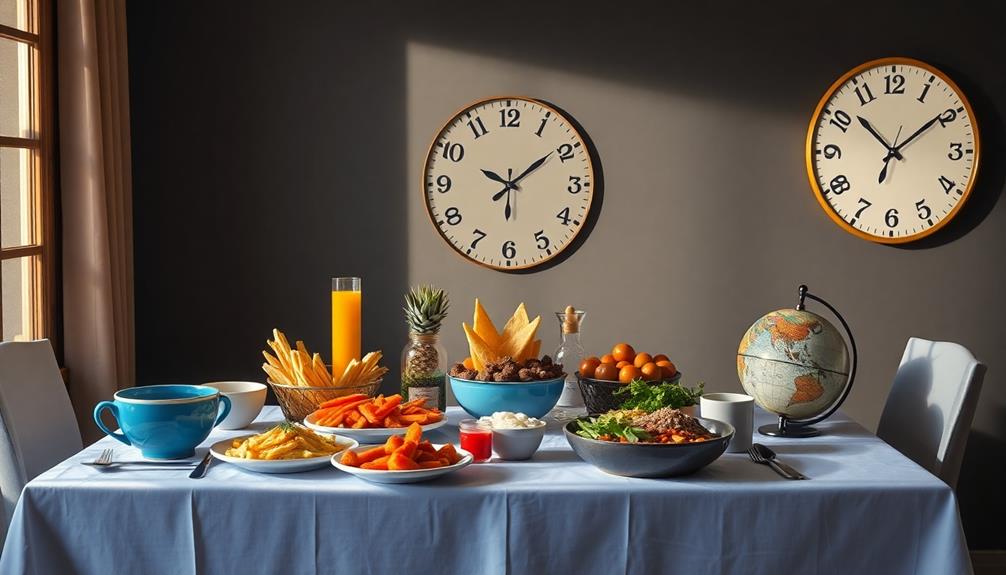
Meal timing plays a crucial role in regulating your circadian rhythms and overall metabolic health. When you stick to regular meal patterns, your body aligns more effectively with its natural cycles. For instance, indulging in classic American comfort foods like a Loaded Baked Potato or a hearty Chefs Salad at consistent times can help reinforce these rhythms.
However, many experience social jet lag, especially when weekend eating habits differ greatly from weekday routines. This inconsistency can create a meal timing variability that disrupts your circadian rhythms, leading to negative metabolic outcomes.
Research shows that irregular meal patterns are linked to unfavorable gut microbiome composition and increased ghrelin levels, which can heighten your appetite for energy-dense foods. If you're eating at odd hours or during your body's resting phases, you might be setting yourself up for obesity and other metabolic issues.
Studies indicate that even minor adjustments in your meal schedule can positively influence weight management. For instance, a study found that participants often ate breakfast about two hours later on weekends, which contributes to social jet lag.
Recovery Strategies
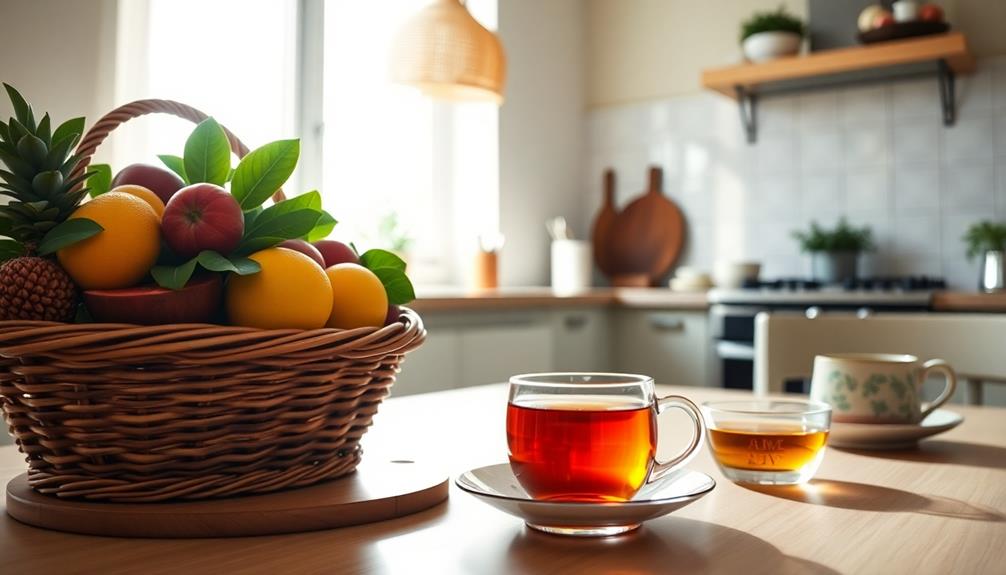
Experiencing jet lag can be a disorienting challenge, but effective recovery strategies can help you bounce back more quickly. To realign your circadian rhythms and minimize disruptions, consider the following:
- Optimize Meal Timing: Before your flight, eat a lighter meal and schedule your meals according to your destination's time zone. A hearty breakfast upon arrival can help kickstart your body clock.
- Control Light Exposure: Deliberate exposure to light and dark is key. Spend time in natural light during the day and limit light exposure before bedtime to signal your body when to rest, aiding in regulating your sleep cycles.
- Consider Sleep Aids: If you're struggling to adjust, using sleep medications or melatonin can help signal sleep, making it easier to cope with jet lag.
Implementing these recovery strategies can greatly enhance your food choices and overall well-being as you adapt to a new time zone.
Role of Food in Recovery
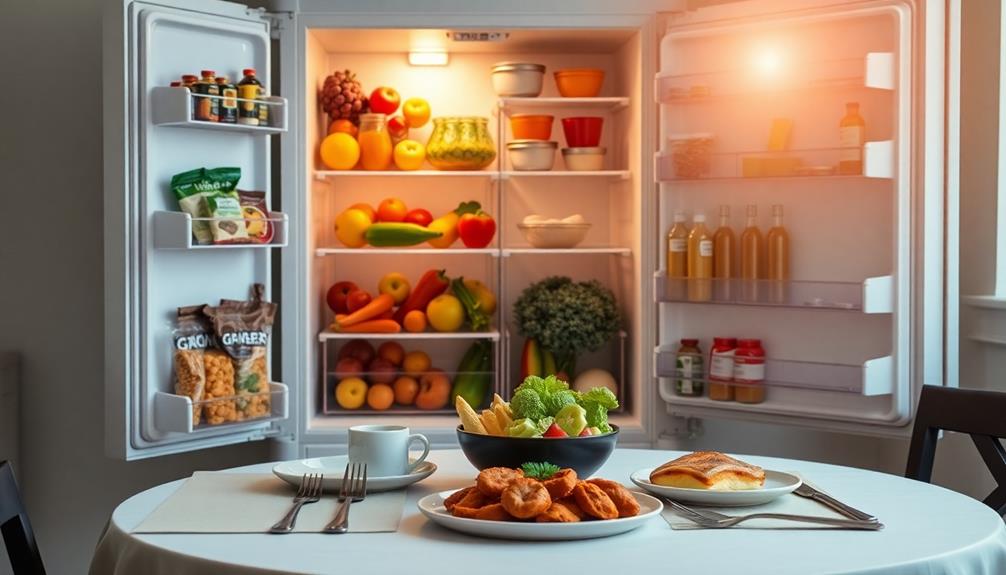
Food plays an essential role in your recovery from jet lag, influencing how quickly you can adjust to a new time zone. Effective meal timing can greatly enhance your recovery process. Before flying, consider having light meals to signal your body to prepare for the change.
Upon arrival, hearty breakfasts packed with high-protein meals can stimulate alertness and activate your body's catecholamine pathway, helping you adapt faster.
Aligning your food intake with the local time zone is important. Research shows that adjusting meal schedules can reduce recovery time from jet lag by up to one-third.
After arriving, deliberate exposure to daylight also plays a fundamental role in resetting your circadian rhythms, which directly impacts your metabolism and eating habits.
Incorporating light dinners before your flight not only aids in a smoother adjustment but also prepares your body for the upcoming change.
By prioritizing appropriate meal timing and the right types of food, you can enhance your recovery from jet lag, making the adjustment to a new time zone much more manageable.
Future Research Directions
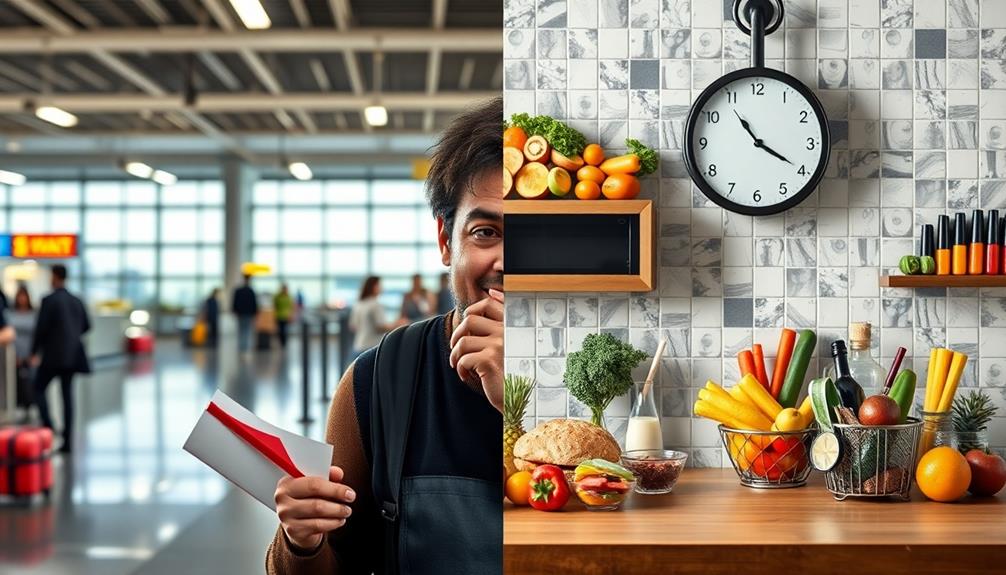
As researchers look ahead, exploring the intricate relationship between meal timing and health outcomes becomes increasingly vital.
Understanding how meal timing variability impacts dietary habits, particularly in populations affected by chronic diseases, is significant. Here are a few future research directions to examine:
- Investigate the long-term effects of meal timing variability on weight and health outcomes, especially in shift workers and those with chronic meal timing variability.
- Validate the association between social jet lag and dietary habits, examining how irregular meal patterns influence nutritional choices across diverse populations.
- Explore the physiological mechanisms behind circadian rhythms and their effects on food preferences, particularly concerning obesity and chronic diseases.
Frequently Asked Questions
Does Jet Lag Affect Your Appetite?
Yes, jet lag does affect your appetite. You might notice you're hungrier, especially for high-calorie foods, due to hormonal changes and disrupted sleep patterns, which can lead to poor eating habits and delayed meal times.
Does Jet Lag Affect Digestion?
Absolutely, jet lag can wreak havoc on your digestion! Your internal clock gets totally confused, leading to sluggish metabolism and digestive distress. If you don't manage your meal timing, things can spiral out of control.
What Is a Jet Lag Diet?
A jet lag diet helps you realign your body's clock by timing meals to match your destination. You'll eat lighter before flights, larger breakfasts upon arrival, and adjust your meal schedule to local patterns for better recovery.
How Does Jet Lag Affect Your Health?
Jet lag disrupts your sleep patterns, leading to fatigue and increased cravings for unhealthy foods. This can affect your overall health by promoting poor dietary choices, weight gain, and potentially increasing your risk for chronic illnesses.
Conclusion
In the whirlwind of travel, you might notice how jet lag nudges your food choices off course, just like the way your sleep schedule gets tangled. It's no coincidence that as your body struggles to adapt, your cravings shift too. By tuning into your circadian rhythms and choosing the right foods, you can harmonize your gut health and restore balance. So next time you travel, remember: your plate can be your ally in beating jet lag.
Nutrition
The Hidden Influence of Plate Color on Taste Perception
What if the color of your plate could change how delicious your food tastes? Discover the surprising connections between color and flavor perception.
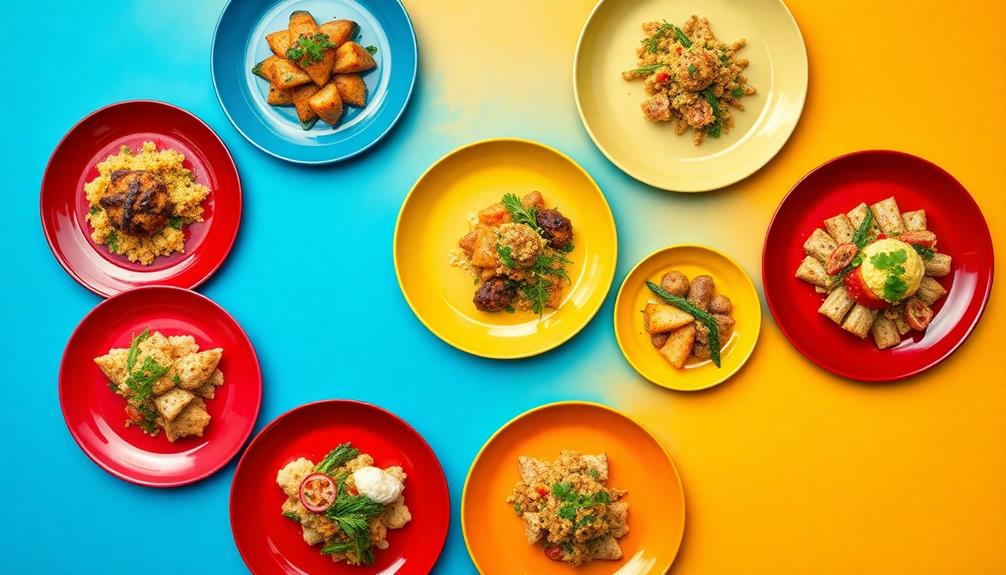
The color of your plate can greatly impact how you perceive taste. Research shows that white plates can enhance the perceived sweetness of desserts by about 20%, making them more appetizing. In contrast, black plates tend to lower the enjoyment ratings. The visual presentation, including color and shape, plays an essential role in food perception and overall satisfaction. This influence isn't just about aesthetics; it can even affect how much food you feel like eating. Understanding these effects can elevate your dining experience, revealing deeper connections between sight and taste that you might find intriguing.
Key Takeaways
- Plate color significantly affects taste perception, with white plates enhancing sweetness and flavor intensity compared to darker colors.
- Desserts presented on white plates average an appetizing rating of 7.7, while black plates yield a lower rating of 5.0.
- High color contrast between food and plate enhances perceived freshness and can increase serving sizes by nearly 10%.
- Cultural influences shape aesthetic preferences, impacting how different plate colors are perceived in relation to food.
- Understanding the effects of plate color can help chefs optimize dish presentation and enhance overall dining experiences.
Understanding Taste Perception
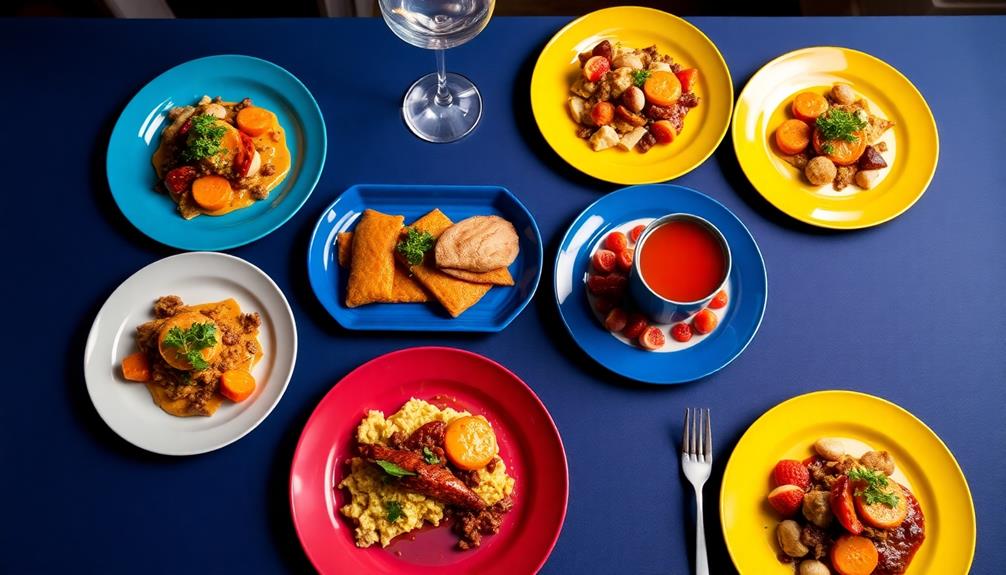
Taste perception goes beyond just the flavors in your food; it's also shaped by what you see. When you sit down to enjoy desserts, the presentation plays a vital role in how you perceive their taste. This concept can be likened to how the rich flavors of dishes like Red-Braised Pork Belly are enhanced by their presentation.
Studies show that the color of the plate can considerably influence your perception of sweetness. For instance, desserts served on white plates often receive higher sweetness ratings—up to 20% more—compared to those on black plates.
This influence of plate color extends to your overall enjoyment and judgment of food quality. When you see desserts presented on black square plates, they might seem more sophisticated, yet the perceived sweetness diminishes. Visual cues, like color intensity, also correlate strongly with flavor intensity ratings, making the plating an essential aspect of your dining experience.
Next time you enjoy a dessert, consider how the plate's color is affecting your taste perception. It's fascinating how your senses interact, and understanding this connection can enhance your appreciation for meals. By acknowledging the influence of visual presentation on taste, you can elevate your dining experiences to new heights.
The Role of Plate Color
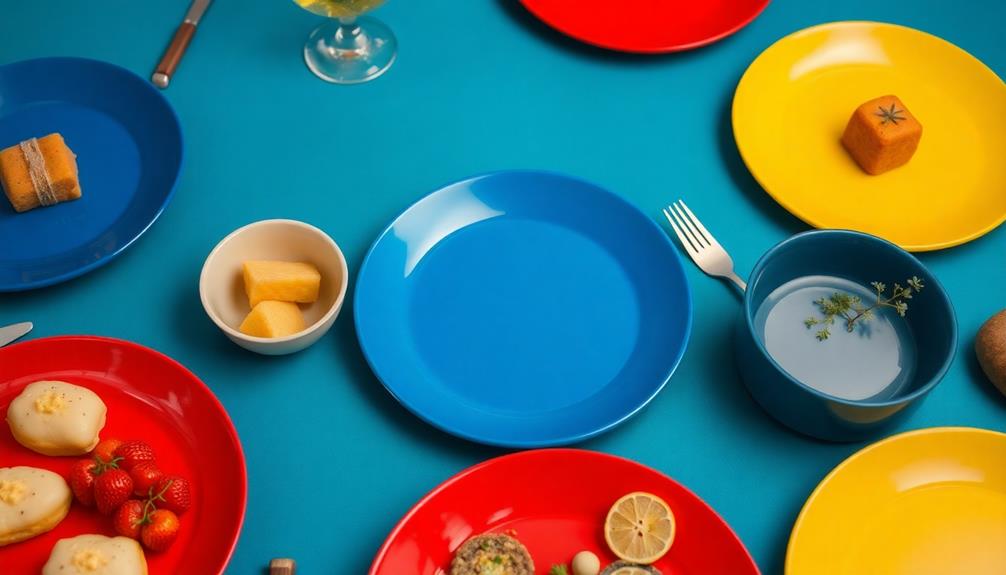
When you think about how food tastes, the color of the plate plays a significant role in your perception of flavor.
For instance, brightly colored plates can enhance the appeal of dishes like Caldeirada, making the vibrant colors of the seafood and spices pop, which may lead to a more enjoyable experience.
You mightn't realize it, but the visual appeal of your meal, influenced by plate color, can enhance or diminish your overall dining experience.
Plus, cultural aspects can shape your aesthetic preferences, adding another layer to how you enjoy your food.
Color and Flavor Perception
Studies show that the color of the plate you use can dramatically shape your flavor perception. For instance, desserts served on white plates often receive higher appetizing ratings compared to those on black plates. A study highlighted that Dessert A scored an average of 7.7 on a white plate, while it dropped to 5.0 on a black plate. This indicates a strong correlation between plate color and taste perception.
White plates can enhance perceived sweetness by about 20% and flavor intensity ratings by approximately 30%, especially for low-sugar desserts. These findings emphasize the significant role of visual presentation in shaping your sensory perception.
Here's a quick summary of the differences in dessert ratings based on plate color:
| Plate Color | Appetizing Rating | Flavor Intensity |
|---|---|---|
| White | 7.7 | High |
| Black | 5.0 | Low |
| White | Enhances Sweetness | +20% |
| Black | Reduces Sweetness | -20% |
Understanding how plate color influences consumer expectations can ultimately enhance your dining experience.
Visual Appeal and Experience
The visual appeal of a dish extends beyond just its ingredients; it encompasses the entire dining experience, prominently influenced by plate color. For instance, a beautifully arranged plate of Agnolotti can be visually enhanced by the choice of plate, making the handmade pasta even more enticing.
Studies reveal that the color of the plate markedly alters your perception of food, particularly desserts. When you enjoy a dessert on a white plate, it's rated as more appetizing—averaging 7.7 compared to just 5.0 on a black plate. This stark difference highlights how your experience can change based on visual cues.
White plates enhance perceived sweetness by about 20% and boost intensity ratings by 30%. In a study with 48 participants, those using white plates consistently rated desserts as sweeter than those on black plates.
The interaction between plate color and dessert type is essential, as it shapes overall flavor perception. High positive correlations between visual hedonic attributes and overall liking indicate that the aesthetics of plate color can elevate your satisfaction while dining.
Ultimately, the color of your plate plays a fundamental role in how you perceive the taste and enjoyment of your meal, transforming an ordinary dish into a delightful experience.
Cultural Influences on Aesthetics
Cultural influences shape not just what's on your plate, but also how the plate itself is viewed. Different cultural traditions dictate distinct plate designs and arrangements, impacting your dining experiences. For instance, Americans often favor center-right placements, while Japanese diners prefer center-bottom, and Italians choose bottom-right. These unique aesthetic choices reveal how cultural context affects food presentation.
Consider these emotional responses to plate design:
- Warmth: Colorful, patterned plates evoke feelings of joy and excitement, much like the vibrant presentation of a dish such as Mushroom Masala.
- Nostalgia: Traditional designs can remind you of cherished family gatherings.
- Elegance: Minimalistic, round white plates enhance sophistication and simplicity.
- Adventure: Unconventional colors spark curiosity and a willingness to try new dishes.
Round white plates, known to enhance sweetness, resonate differently across cultures due to varying associations with color perception. Chefs can harness these insights, tailoring plate colors and designs to cater to diverse consumer preferences.
Additionally, environmental factors, including the cultural context of dining, can shift how you perceive colors and shapes. By understanding these influences, you can elevate your dining experiences and truly appreciate the art of food presentation.
Aesthetic Appeal in Dining
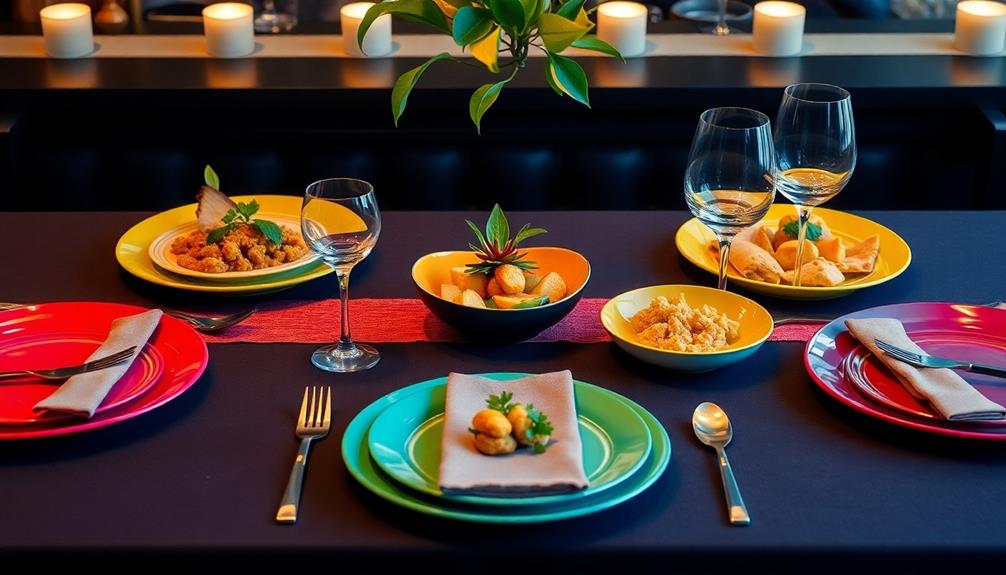
Aesthetic appeal plays an essential role in dining experiences, affecting how you perceive taste and quality. The color of the plate can considerably influence food perception; for instance, desserts served on white plates often receive higher ratings than those on black plates. This preference underscores the importance of visual presentation. Research shows that white plates can enhance perceived sweetness and intensity, making desserts seem more enjoyable.
For example, traditional Indonesian desserts like Kue Putu and Dadar Gulung are often presented on vibrant plates to highlight their colors and textures.
Moreover, the aesthetic appeal of plate design can evoke emotional responses, leading to positive feelings that correlate with tastiness and quality. Contrast effects also play a vital role in serving sizes—high contrast can lead to larger servings, while low contrast often results in less food. This visual impact directly influences customer satisfaction, as appealing presentations can enhance your overall dining experience.
Chefs can optimize food presentation by carefully selecting plate colors and designs, ultimately boosting dessert ratings and increasing enjoyment. By understanding the connection between plate color and food perception, you can appreciate how these elements come together to create a memorable meal.
Impact of Plate Shape

When it comes to dining, plate shape can dramatically alter your perception of taste. You mightn't realize it, but the plates you choose can influence your enjoyment of food in surprising ways.
For instance, round plates often enhance the sweetness of desserts, making them more appealing. This effect can be particularly interesting when serving festive dishes like Graveyard Taco Dip, where the presentation is key to enjoyment.
Here are four ways plate shape impacts your dining experiences:
- Sweetness Boost: Round plates can increase perceived sweetness by about 20%, especially for low-sugar desserts.
- Quality Ratings: Desserts on black square plates receive higher quality ratings compared to those on white square plates.
- Familiarity Matters: Round plates are more commonly associated with positive dining experiences, leading to better overall quality ratings.
- Color Interaction: The combination of plate shape and color can further influence taste perception, enhancing or dampening flavor expectations.
Cultural Influences on Plating
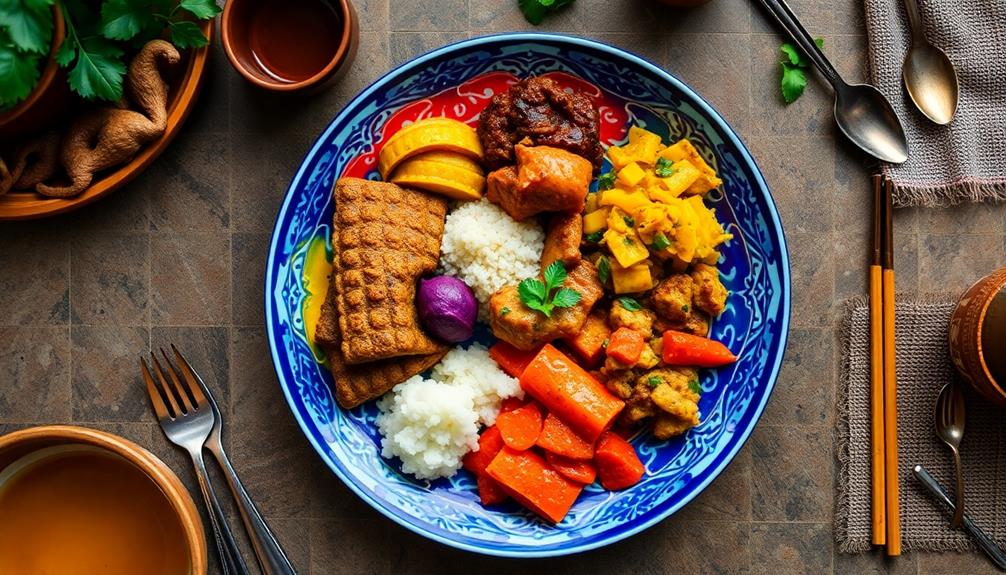
Plate shape isn't the only factor that plays a role in how you perceive food; cultural influences also shape the way dishes are presented. Cultural traditions dictate plate design, with specific colors and patterns reflecting various cuisines. For instance, floral patterns are common in Asian plating styles, while other cultures have their unique preferences.
You might notice that Americans often place food in the center-right of plates, whereas Japanese diners prefer the center-bottom, and Italians lean towards the bottom-right. These food placements reveal diverse cultural aesthetics that directly affect your taste perception.
In Greek cuisine, for example, the rustic presentation of dishes like Horiatiko Psomi emphasizes simplicity and authenticity, enhancing the overall dining experience. The balance in plating is essential for enhancing consumer pleasure; cultural perceptions of symmetry and order can shape your plating preferences.
Chefs use plates as canvases, adapting their food presentation to align with these cultural expectations. Additionally, studies show that cultural variations influence how you react to "offensive" cues in food placement, highlighting the importance of aesthetic choices in plating.
Ultimately, understanding these cultural influences can enhance your dining experience, making you more aware of how presentation impacts your overall enjoyment of a meal.
Experimental Findings Overview
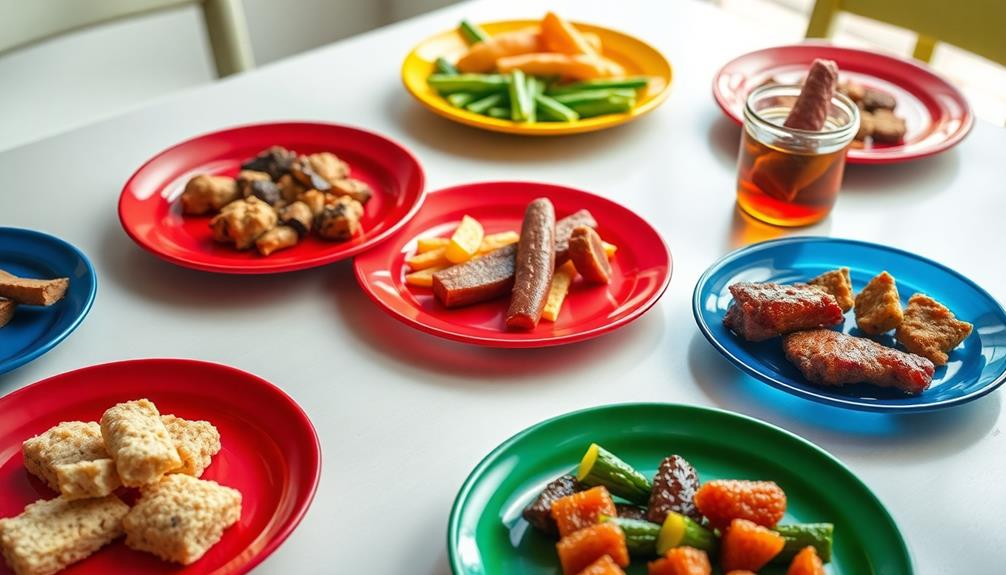
In exploring how plate color impacts your perception of taste, you'll find some intriguing results.
Studies suggest that the visual presentation of dishes, such as those from diverse culinary traditions like Asian Cuisine, can greatly influence our taste perception.
For instance, desserts served on white plates often seem more appetizing than those on black plates, but this effect varies with dessert type.
Understanding these nuances can really enhance your dining experience and enjoyment.
Plate Color Impact
How does the color of a plate influence your perception of food? Research shows that plate color markedly impacts your experience, especially with desserts. For instance, desserts served on white plates received an average appetizing rating of 7.7, while those on black plates averaged only 5.0. This stark contrast demonstrates the strong influence of plate color on food perception.
The same principle can apply to savory dishes found in diners, such as a Loaded Baked Potato or a Chef's Salad, where the visual presentation can enhance the overall dining experience.
Here are four emotional takeaways about plate color's impact:
- Visual Appeal: A bright plate can make your dessert look more inviting.
- Enhanced Sweetness: White plates can boost sweetness ratings by about 20%, making treats even more delightful.
- Flavor Perception: The intensity of flavors can change based on the plate, altering your enjoyment.
- Chef's Canvas: Chefs can use color contrast to enhance customer enjoyment and satisfaction.
These findings reveal that plate color plays a pivotal role in presentation ratings and overall food perception.
Dessert Type Variability
The impact of plate color varies not just by color itself but also by the type of dessert being served. For instance, traditional Japanese confections like Dorayaki (Red Bean Pancake) may evoke different responses based on their presentation.
In a recent study, dessert A received a higher appetizing rating on a white plate (M = 7.7) compared to a black plate (M = 5.0), showcasing notable differences in perception based on dessert type and plate color. Dessert C followed a similar trend, rated more appealing on a white plate (M = 7.4) than on a black plate (M = 6.8).
However, dessert B was preferred on a black plate (M = 7.5) over a white plate (M = 6.8), illustrating that not all desserts react similarly to plate color.
Flavor intensity ratings further emphasized these notable interactions. The perceived sweetness of desserts varied based on both plate color and the specific dessert served.
Visual Presentation Effects
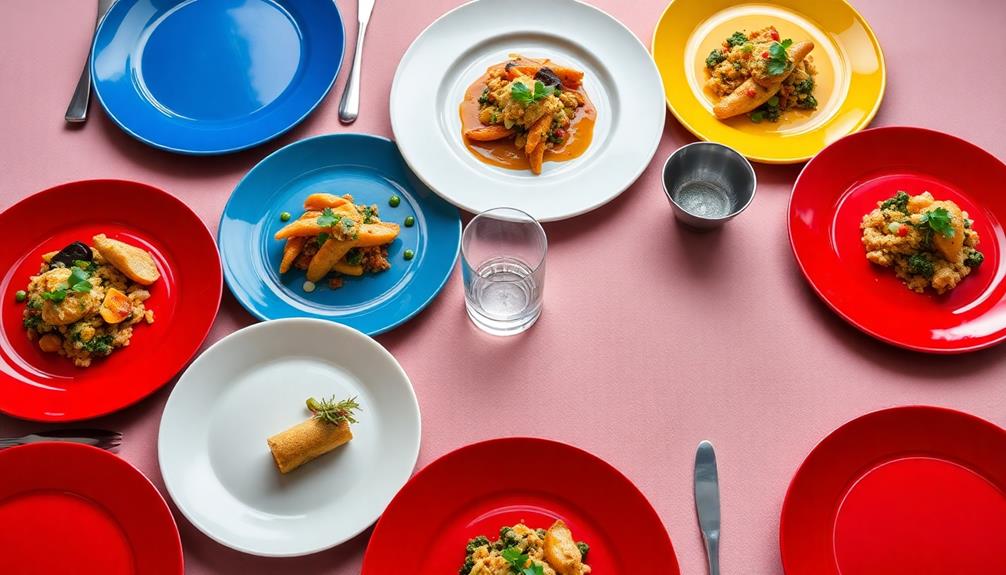
When you sit down to enjoy a meal, the visual presentation of the food plays an essential role in your overall experience. The color of the plate can notably influence food perception, affecting everything from dessert ratings to flavor intensity.
Here are four ways visual presentation impacts your dining experience:
- Aesthetic Appeal: Desserts on white plates score higher in appetizing ratings than those on black plates, like Dessert A's 7.7 versus 5.0.
- Sweetness Perception: White round plates can enhance sweetness ratings by approximately 20%, transforming your perception of flavors.
- Serving Size Influence: High color contrast between food and plate can increase serving sizes by 9.8%, while lower contrast decreases them by 13.5%.
- Overall Satisfaction: The right plate color enhances customer satisfaction, making every bite more enjoyable.
These elements of visual presentation shape your sensory experiences, showing that the aesthetic aspects of plate color matter more than you might think.
The next time you dine, consider how the colors surrounding your food influence not just how it looks but also how you taste it.
Practical Implications for Chefs

Understanding the impact of plate color on taste perception can greatly elevate your culinary creations. As a chef, you can markedly influence the perception of food by choosing the right plate color.
For instance, serving desserts on white round plates can enhance sweetness ratings by about 20% compared to black plates. If you're presenting overly sweet dishes, consider using black square plates, as they can boost perceptions of quality and liking.
Visual appeal plays an essential role in how your dishes are perceived. One study found that a dessert rated 7.7 on a white plate was considered more appetizing than a 5.0 on a black plate.
High color contrast between the plate and food not only enhances visual appeal but also encourages larger serving sizes—research indicates a 9.8% increase in self-serving amounts when using high contrast presentations.
Future Research Directions
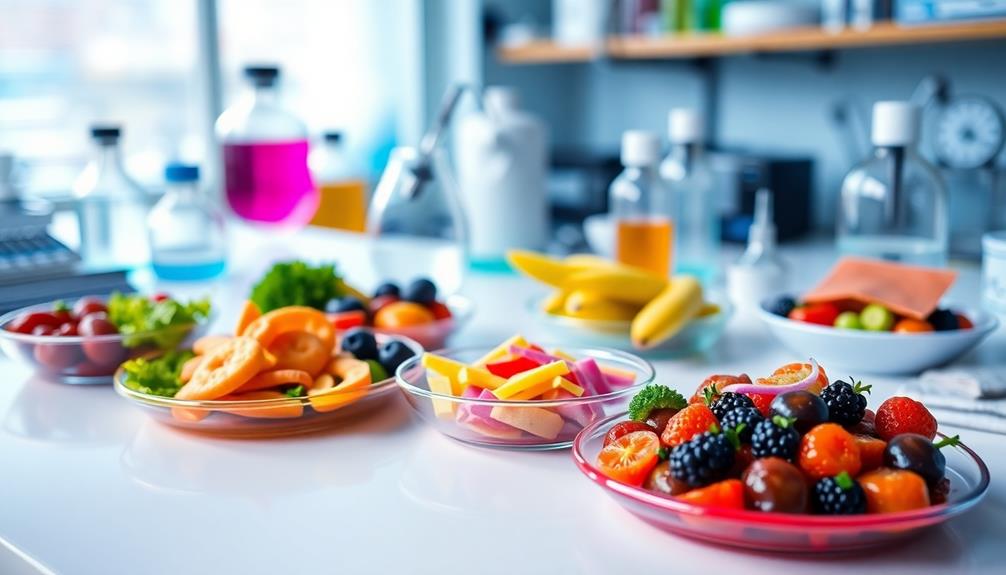
As chefs harness the influence of plate color on taste perception, it's important to contemplate what future research can uncover about this fascinating interaction. By delving deeper into the psychological interactions at play, we can better understand how plate color shapes our experience of food.
Here are some exciting directions for future studies:
- Investigate specific mechanisms: Explore how plate color alters taste perception through sensory and psychological processes.
- Examine plate shapes: Assess how different plate shapes, in conjunction with color, impact consumer judgments of food.
- Broaden food types: Expand studies to include various food types and cultural contexts, ensuring findings are applicable across diverse dining experiences.
- Utilize neuroimaging techniques: Leverage advanced neuroimaging methods to uncover the cognitive processes and emotional responses evoked by plate aesthetics during meals.
These avenues of research can enhance our understanding of flavor expectations and preferences over time, ultimately refining how we experience food.
Frequently Asked Questions
How Does Color Affect the Perception of Taste?
Color greatly affects your taste perception. Bright or vibrant colors often enhance sweetness and appeal, while darker shades might create different expectations. Your brain associates specific colors with flavors, influencing how you experience food.
How Does the Color of the Plate Affect Your Food Presentation?
The color of your plate greatly impacts food presentation. Using contrasting colors makes portions appear larger and more appealing, while white plates enhance the perceived attractiveness of your dishes, making them more appetizing to your guests.
Does the Color of Your Plate Affect How Much You Eat?
Yes, the color of your plate does affect how much you eat. High contrast colors can make you serve more, while low contrast colors might trick you into thinking you've got enough, leading to smaller portions.
Conclusion
So, the next time you sit down for a meal, remember: it's not just the food that matters, but the color of your plate. Who knew that a simple shade could elevate your dining experience? It's almost laughable that something so seemingly trivial could influence your taste buds so profoundly. Yet, here we are, letting the aesthetics dictate our enjoyment. Maybe it's time to rethink your dinnerware—or just embrace the irony and enjoy your meal, no matter the hue!
-

 Vetted2 months ago
Vetted2 months ago15 Best Sports Recovery Tools to Enhance Your Performance and Speed Up Healing
-
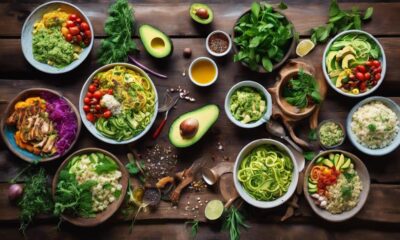
 Nutrition3 months ago
Nutrition3 months agoJoin the Low Carb Craze and Lose Weight Fast!
-

 Nutrition3 months ago
Nutrition3 months agoEat Healthy With This Atkins Carbohydrate Counter!
-

 Nutrition3 months ago
Nutrition3 months agoGet the Keto Ratio Right for Maximum Results!
-

 Nutrition3 months ago
Nutrition3 months agoGuide : How To Count Calories
-

 Lifestyle2 months ago
Lifestyle2 months agoHealthy Lifestyle Blogs – Follow for Inspiration and Tips!
-

 Nutrition3 months ago
Nutrition3 months agoFind the Best Low Carb Fast Food Options for Keto Diet!
-

 Recipes3 months ago
Recipes3 months agoQuick and Easy Steamed Mahi Mahi With Hummus!

























